
Datenschutzerklärung
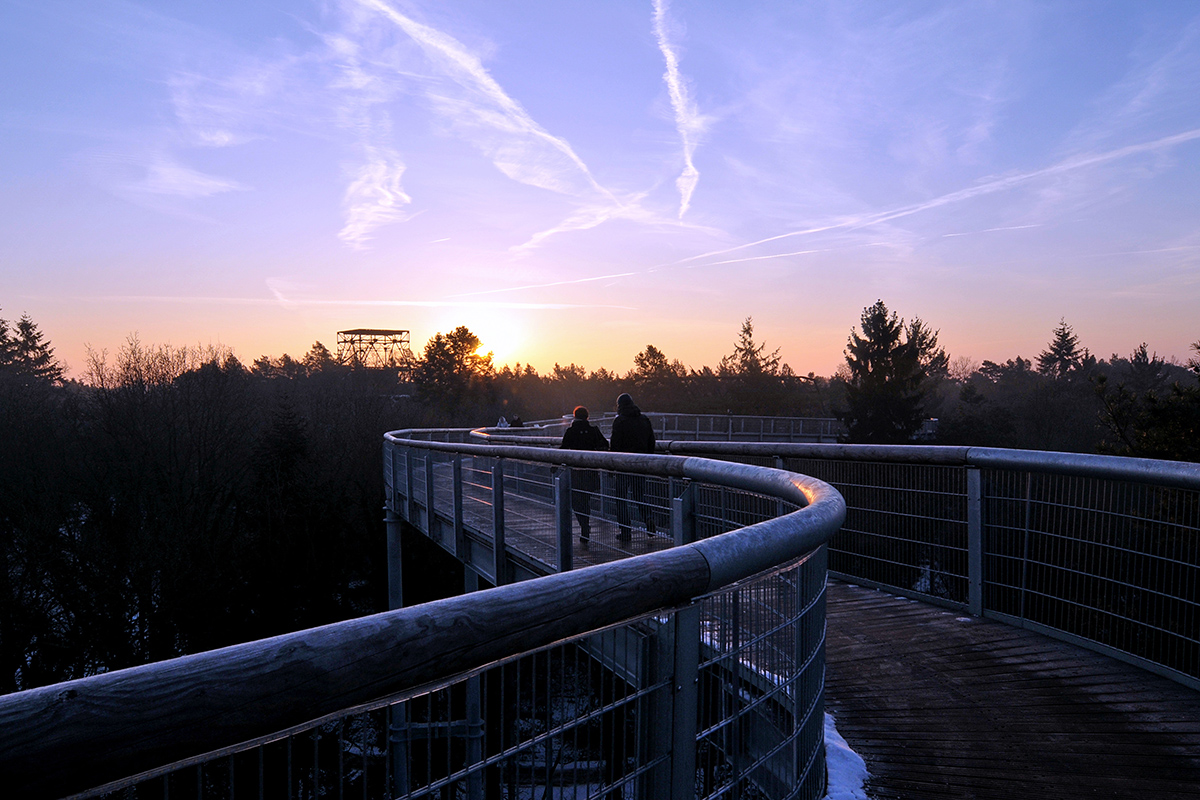
More than 100 years ago, the famous “Beelitzer Heilstätten” were created . Nowadays, a unique tree top and time travel path (barrier free) is winding above the World War II ruins of an Alpine house. In the old days, the working population of the imperial capital of Berlin was supposed to recover from the then rampant tuber culosis surrounded by the finest architecture and extensive forest parkways . Ever since, the flow of time with all its exciting developments and of course with many – very different – occupants and visitors has left its distinctive and visible marks. During your visit, you will discover the old buildings which, resembling old castles, exude their very own unrivalled beauty and charm.
Either on your own or as part of a guided tour you can stroll through a world in which normally only birds spread their wings . Here, you will get some exciting and unique insights into the history, stories and nature related to this place rescued from destruction. The 40-metre-tall viewing tower offers some spectacular views and vistas, from the Fläming region all the way to Berlin. The lift takes you all the way to the top.

“It was only when I put my wish into practice which I had cherished from a young age, when I started to study architecture a joyful life began inside of me.”
Heino Schmieden, 1835 – 1913
The architect Heino Schmieden shaped the face of various German cities in the Wilhelmine era, particuarly through the creation of public buildings. Concert halls, museums, courts, university and administrative build ings – and first and foremost hospitals were designed by Schmieden. For this reason, he was the leading archi tect during the founding and erection phases of the Beelitz sanatoriums (1898-1902).
Together with his childhood friend and business companion Martin Gropius he strove to create a modern, people-oriented form of architecture which considered creative beauty to be an inextricable part of the function of a building . The Beelitz sanatoriums are a proof of this pretence. The architectural critic Gerwin Zohlen wrote in 2012: “Even in today’s ruinous and shred ded state the Beelitz sanatoriums are the hard-to-grasp document of an architectural and aesthetic overspill as well as overvalue, which was dedicated to social and medical purposes in its day. The dignity, stance and the commitment which the sanatoriums eradiate appear to be almost unimaginable today , particularly so as all these efforts were made for the lower and middle classes. And at the same time, they are a testimony of the architectural skills which certainly existed 100 years ago.”
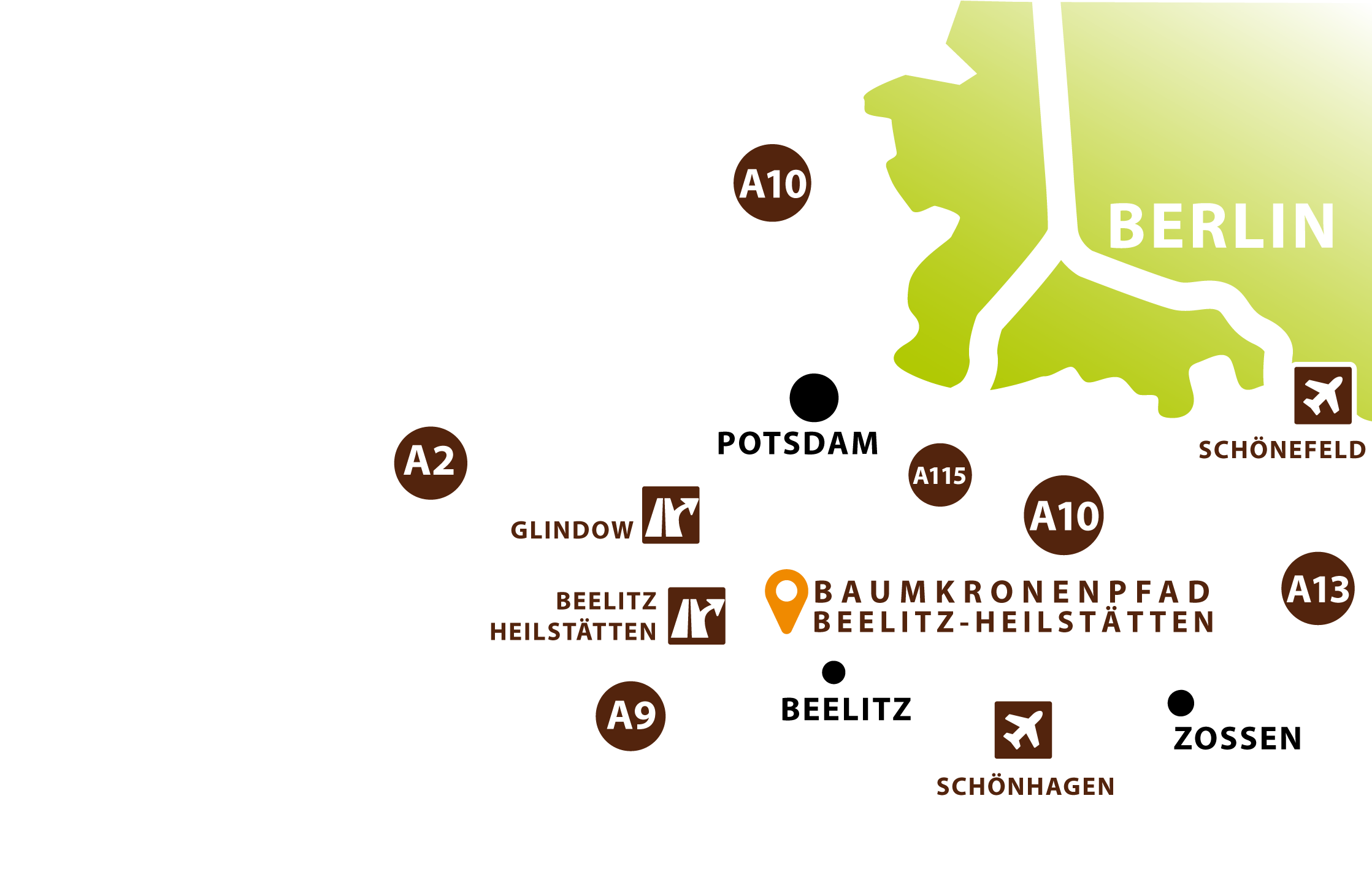
Admission fees
- Visitors on their birthday: free
- Children up to 6 years of age supervised by an adult: free
- Adults from 18 years of age: € 17,00
- Children and adolescents 7-17 years of age: € 12,00
- Pensioners, students, disabled people, pupils (presentation of valid identification required): € 15,00
- Family ticket, 2 adults and own children/grand children under 18 years of age: € 39,00
- Family ticket, 1 adult and own children/grand children under 18 years of age: € 25,00
- Groups with at least 15 paying participants paying together, per person: € 13,50
- School classes/kindergarten/etc.: upon request
- Annual ticket: € 40,00
- Annual ticket for children: € 30,00
- Annual ticket for families, adults and own children/grand children under 18 years of age: € 100,00
Opening hours 2020
- March: Saturday and Sunday from 10am to sunset
- April through September: daily 10.00 am - 7.00 pm
- October & November: daily 10.00 am until sunset
- December through February: Saturday & Sunday 10.00 am - 4.00 pm
The ticket office closes one hour before closing time!
How to find us
- A9 motorway Berlin – Leipzig – Nürnberg → Exit 2 Beelitz-Heilstätten (direct access to the car park of th e “Tr ee Top Walk” via the roundabout).
- B2 highway Potsdam – Wittenberg – Leipzig→ in Beelitz follow the signs to Beelitz-Heilstätten respectively Baumkronenpfad.
- RB7 regional train Berlin – Dessau→ Beelitz-Heilstätten station→ signs towards Baumkronenpfad .
- European Bicycle Route R1 London – Berlin – St. Petersburg→ On the sanatorium’s premises go towards the L88 road ( Beelitz-Lehnin ).
Baum & Zeit – Baumkronenpfad Beelitz-Heilstätten Straße nach Fichtenwalde 13, 14547 Beelitz, Germany You can contact us by phone on +49(0)033204/6058-10. e-mail: [email protected]
facebook.com/baumundzeit www.baumundzeit.de

The forest park
Long stays in the fresh air, such as extensive walks and rest cures, were part of the therapies in Beelitz in any season of the year. Before even the first building of the sanatorium was erected the gardens were designed to benefit the patients with the help of the gardeners of the nearby imperial parks of Potsdam. A part of the original pine forest was integrated into the park landscape. Even today, around 65 different tree and shrub species are to be found on the premises, which creates a marvellous play of colours particularly in the spring and in the autumn. This floral splendour is complemented by countless flowers in large flower beds.
A special botanical highlight is the forest roof on top of the World War II ruin of the Alpine house. Trees have been growing here since 1945. Also the other castle-like buildings are grown over by climbing plants and pioneer plants provide some extravagant motifs which are usually to be expected on temples in the jungle. Step by step, the old structures of the park are brought back to the light of day. Go ahead and discover them!
Around the tree top walk
Two different walks with nature guide Claas Fischer will lead you to the remarkable woods in the sanatorium park, making you familiar with their identifying characteristics and providing interesting facts about their ecological, medical and culinary benefits. These walks are exciting complements to your individual discoveries on the Tree Top Walk.
Guided tours
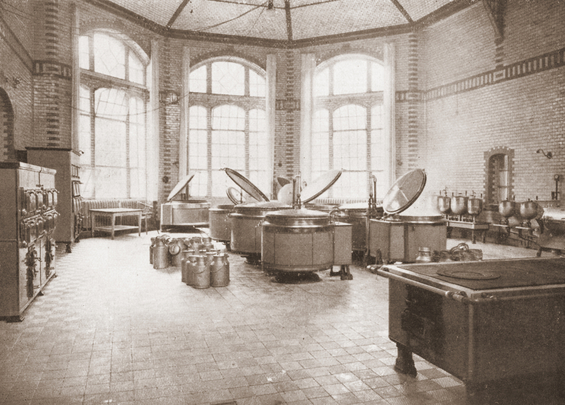
Zeitenwandel – Wandelzeiten (Changing times – time to stroll)
A walk through the history of and stories about the Beelitz sanatorium
You will spend one hour strolling along the historical paths of the Beelitz sanatoriums together with our knowledgeable tour guides, getting to know some interesting and funny details from the patients’ lives between the solarium, the dining hall and the Alpine gorge. Discover this magnificent area with its more than 100 years of history, which offers various relics from the ever-changing German history . Gain insights into the premises’ architecture and nature.

What would a trip into the countryside be without a delicious snack, a cosy lunch or a piece of cake?
Gastronomy in the discovery area of “Baum & Zeit”
In the pavilion of the “Bistro am Baumkronenpfad” , beside the viewing tower and a playground, a young team welcomes you with their culinary offers. During the main season, the large terrace and the beer garden offer some space in the open (approx. 200 seats).
Culinary offers near the discovery area “Baum & Zeit”
In the immediate vicinity of the discovery area, for which an admission ticket is required, you will find the “Restaurant & Landhotel Gustav” (approx. 600 metres from the pay desk) is immensely popular. It is located directly on the L88 road, which divides the quadrants A and B of the Beelitz sanatoriums.
Tip: The Tree Top Walk is situated in the middle of the Beelitz Asparagus District. Do not miss this delicacy during its high season (spring until 24 June).
Guided tours in English can be arranged upon request.
Tour: Time change-change times A walk through the eventful history of Beelitz Heilstätten
Entertaining, historical tour of the area (barrier-free, outdoor)
- Duration: 1 hour
- Group price: €200,00 (max. 30 participants; arranged upon request)
- All prices plus admission fee to the Tree Top Walk.
- no age restriction.
Information for individual bookings: +49(0)33 204 – 60 58 25 / [email protected]
Tour: „Fascination – Alpenhaus“: World War II ruin – biotope – film set “ Thematic guided tour of the building with explanations of the overall facilities as well as the solitary history of the building, its colonization by nature and use as a movie backdrop
Entertaining, guided tour of the building (conditionally barrier-free, indoor)
- Group price: €250,00 (max. 30 participants; arranged upon request)
- Helmet required for all participants
- Age restriction: 7 years +
Information for individual bookings: +49(0)33 204 – 60 58 20 / [email protected]
Tour: Three buildings in one tour! Guided tour of the grounds, history and architecture of Beelitz Heilstätten using the example of three buildings from the imperial era Indoor – thematic building tours, not barrier – free
- Duration: 1,5 hours
- Group price: €300,00 (max. 30 participants; arranged upon request)
- Age restriction: 14 years +
Information for individual bookings: +49(0)33 204 – 629 765 / [email protected]
Tour: The old surgery building – The spirit of „Beelitz-Heilstätten“ Guided tour on the history, architecture and use of the most famous house at the „Heilstätten“ Indoor – thematic building tours, not barrier – free
Kontakt Formular
Anstehende veranstaltungen.
Vorerst keine neuen Events
Welche Führung?
Zeitenwandel-Wandelzeiten Durch die alte Chirurgie Chirurgie Total (1,5h) Faszination Alpenhaus Beelitzer Unterwelten-Tunnel & Technik Saved Place Foto Tour Taschenlampen-Führungen BAUM & ZEIT Pförtner – Tour Drei Gebäude - Eine Führung Winter-Wandel Tour
Firma/Verein/Organisation(Pflichtfeld)
Anrede(Pflichtfeld)
Name und Vorname(Pflichtfeld)
Straße(Pflichtfeld)
PLZ/Ort(Pflichtfeld)
E-Mail-Adresse(Pflichtfeld)
Telefonnummer
Wunschtermin
Personenzahl
Gewünschte Uhrzeit
Sprache (Führungen)
Ihre Nachricht
Bitte lasse dieses Feld leer.
Fehler: Kontaktformular wurde nicht gefunden.
- Archive for Catherine Lupton
- Share on: Facebook • Twitter • Google+
- ‹ Previous Post • Next Post ›
- Art & Culture
- Food & Drink
- Historical Berlin
- Walking Berlin
- Contributors
Beelitz Heilstätten: The Phantom Sanatorium
Catherine lupton explores the history of beelitz’s abandoned sanatorium….
T he vast abandoned sanatorium complex known as Beelitz Heilstätten, southwest of Berlin, is surely one of the city’s most flagrantly open secrets.
Easily reached by train from Wannsee , Beelitz is a mythical destination for aficionados of urban exploration (urbex): the clandestine visiting, photographing and filming of abandoned buildings, as well as being an oddly popular spot with ordinary families and couples out for a Sunday picnic or stroll.
Beelitz Heilstätten was built in three discontinuous phases between 1898 and 1930, as a sanatorium commissioned by the National Insurance Institute to house and treat the mushrooming numbers of tuberculosis patients in rapidly-expanding Berlin.
The site in the Beelitzer forest was chosen because it already enjoyed good transport connections to the capital, and met contemporary therapeutic requirements for fresh, smoke- and dust-free air.
The first phase of building work, 1898-1902, under the supervision of the architects Heino Schmeiden and Julius Boethke, established a 600-bed state of the art treatment facility, the patients’ pavilion equipped with large, south-facing balconies for the ‘air-baths’ which were central to the early twentieth-century TB treatment regime.
The second building phase, 1905-08, supervised by Fritz Schultz, doubled the number of available beds, as well as adding outbuildings and infrastructure which turned the complex into a self-contained city for the ill, with its own post office, restaurant, beer garden, nursery, stables, workshops, kitchens, laundry, butcher’s shop and bakery.
The sanatorium was strictly divided along gender lines: women were accommodated to the west of the main road, men to the east.
Beelitz Heilstätten even boasted its own power-generating plant, with a 44-metre high half-timbered watertower, which has been restored and remains one of the most spectacular buildings on the site.
The surrounding countryside might be blanketed in snow, but the warmth from the power plant ensured that the ground at the sanatorium always remained clear.
During World War One, Beelitz Heilstätten was requisitioned for use as a military hospital, and in 1915-16 an infantry solider named Adolf Hitler convalesced there from a thigh wound received at the Battle of the Somme.
The formation of greater Berlin in 1920, combined with the social and economic turmoil of the post-war years, saw patient numbers rising sharply and then falling off during the 1923-24 inflation crisis, when some of the wards were forced to close.
With the return of relative stability in the mid-1920s, the final phase of building was undertaken 1926-30, the centrepiece of which was the women’s surgical building, demonstrating the medical advance of TB treatment into lung surgery.
Until a relatively recent spate of vandalism reduced their contents to wreckage, the operating theatres and their equipment survived miraculously intact, one of Beelitz’s most iconic attractions.
The sanatorium was requisitioned again for military use during World War Two. Parts of the site were bombed: the church was so badly damaged that it had to be demolished, while the women’s pulmonary medicine building remains a compelling, hollow-eyed shell, a virgin forest of fast-growing pines and hazel trees adorning what remains of its roof.
Under the Soviet occupation, Beelitz-Heilstätten became a closed military zone, upgraded for use as the main hospital for Soviet troops stationed in the region, and for high-ranking GDR officials.
In this latter capacity it housed a second notorious patient: in 1990 the deposed GDR leader Erich Honecker was briefly treated at Beelitz, before escaping to Moscow to try and evade prosecution for the deaths of the 192 East German citizens killed trying to escape over the Berlin Wall.
The Soviet military finally withdrew from Beelitz in 1994, and the 200-hectare site entered the to-and-fro limbo between optimistic visions of renewal and steady deterioration that it still occupies today.
From 1997, parts of the site were redeveloped as a medical training facility and rehabilitation centre for neurological disorders and Parkinson’s disease; today these operate cheek by jowl with the eerie, silent, boarded-up pavilions sliding inexorably into ruin.
Beelitz Heilstätten is the largest Grade II listed historical site in the Brandenburg region, so it cannot be simply bulldozed, but apart from the piecemeal purchase and restoration of individual buildings, the funds that would be required to restore and repurpose the site as a whole are conspicuously lacking.
The most recent move has been to erect an elevated walkway over some of the buildings, and open Beelitz up as an official destination made safe for tourism.
But even with these modifications, a visit to Beelitz is still far enough beyond the pale of conventional sightseeing to make for a memorable, if not exactly legal, outing.
Those who prefer to stay within the law can explore the unfenced exterior parts of the site in daytime without much risk of interception, or take one of the informative tours of the sanatorium grounds run by local historian Irene Krause (in German, spring through autumn, no access to any of the buildings).
Still, the real draw of Beelitz for most visitors remains the haunting, magnificently crumbling interiors of iconic structures like the bath house, gymnasium, and surgical buildings.
Entering these is trespassing on private property at your own risk (and derelict buildings are by their nature risky)—even though in the course of any visit you are more than likely to cross well-worn paths with plenty of other intrepid transgressors.
Common sense and caution are needed, especially since, following a fatality a few years ago, the site’s owners are doing more to board over doors and windows and brick up the service tunnels that were a popular route of entry, so gaining access to many of the buildings is by no means straightforward.
Abandoned, and yet a centre of compulsive attention, Beelitz Heilstätten remains well worth exploring, whichever side of the law you choose to enter on.
By Catherine Lupton on December 6, 2012, in Brandenburg , Day Trips & Weekends Away , Historical Berlin , Off The Beaten Track Updated on: March 22, 2023 More Catherine Lupton 5 minutes
Catherine Lupton explores Beelitz's abandoned sanatorium...
Potsdam: An Alternative Architectural Guide
Potsdam resident John K. Peck gives us a tour of his favourite buildings...
Restoring Halbe’s Kaiserbahnhof
Andre Gifkins cycles to the Spreewald to witness a one-of-a-kind royal train restoration...
Stories from the City
To celebrate Slow Travel Berlin's fifth birthday: a curated anthology of articles and photography on a wide range of topics and places that you won’t find in the guidebooks.
100 Favourite Places
Instead of highlighting the city’s hippest ‘hotspots’, we’ve taken a more patient and personal approach to bring you 100 special places, many of which would not be mentioned in conventional guides.
Mauerweg: Stories From The Berlin Wall Trail
A documented walk around the entire 160km length of the Mauerweg (Berlin Wall Trail)
Copyright © 2024 Slow Travel Berlin All rights reserved | Log in

Baumkronenpfad Beelitz-Heilstätten – Treetop Walkway and Abandoned Sanatorium
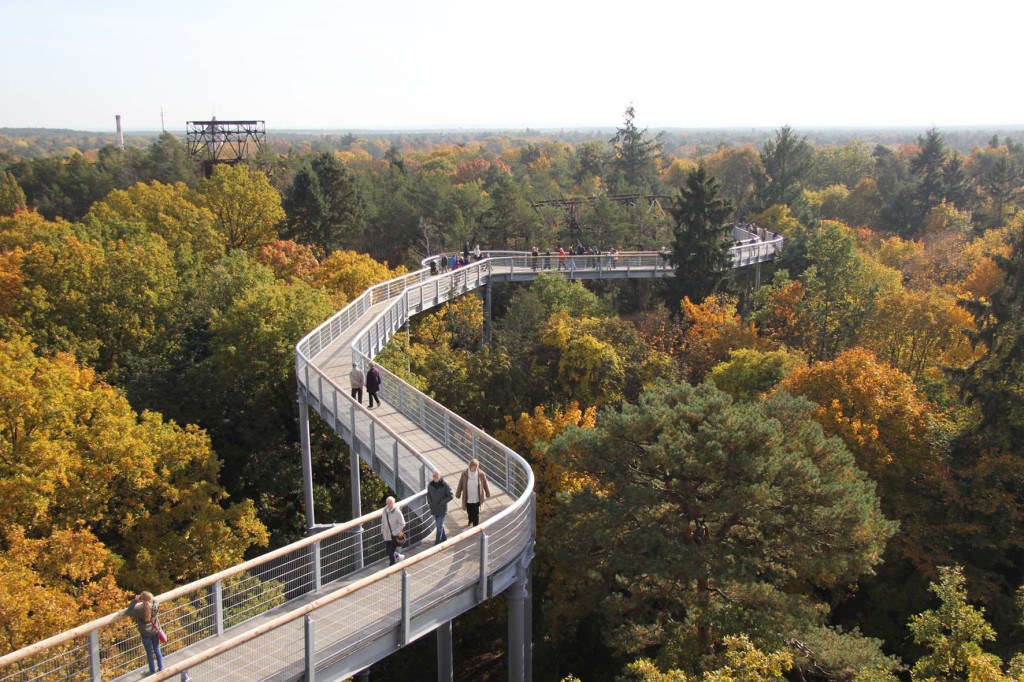
The history of the Beelitz-Heilstätten began in 1898 when the Landesversicherungsanstalt Berlin (the state insurance institute for Berlin) bought an approximately 140-hectare parcel of woodland from the town of Beelitz.
The lung clinic and sanatorium first built there with a capacity of 600 beds received its first patients in the spring of 1902.
Over the following years the land covered by the sanatorium complex more than doubled in area and was extended to include over 60 buildings.
Adolf Hitler recovered here from injuries sustained during the First World War and Erich Honecker was treated for liver cancer before fleeing to Moscow in 1991.
In 1945 the Soviet Army appropriated Beelitz-Heilstätten, which became the largest Soviet military hospital outside the Soviet Union.
Like many of the buildings in East Germany controlled by the Red Army, the sanatorium at Beelitz has stood empty since the withdrawal of Soviet troops from the Germany in 1994.
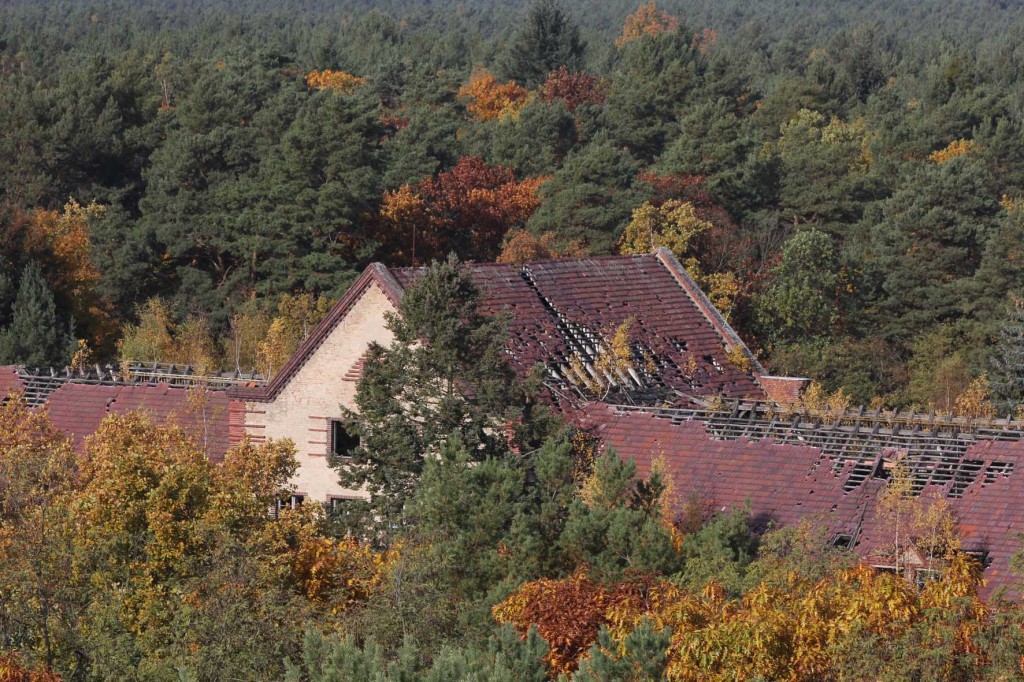
Over the last 20 years Beelitz-Heilstätten has been a favourite of urban explorers and photographers drawn by the strange beauty of peeling paint and nature reclaiming the land.
The opening of the Baumkronenpfad in early September 2015 is the first step in a plan Heilstätten Projektentwicklungs GmbH has to attract visitors by landscaping the parkland and making the abandoned buildings accessible to the public.
The walk over the treetops starts with a 36-metre climb to the top of the main viewing platform. From there you overlook the 23-metre high walkway that extends for 320-metres to the ruins of the old Alpenhaus.
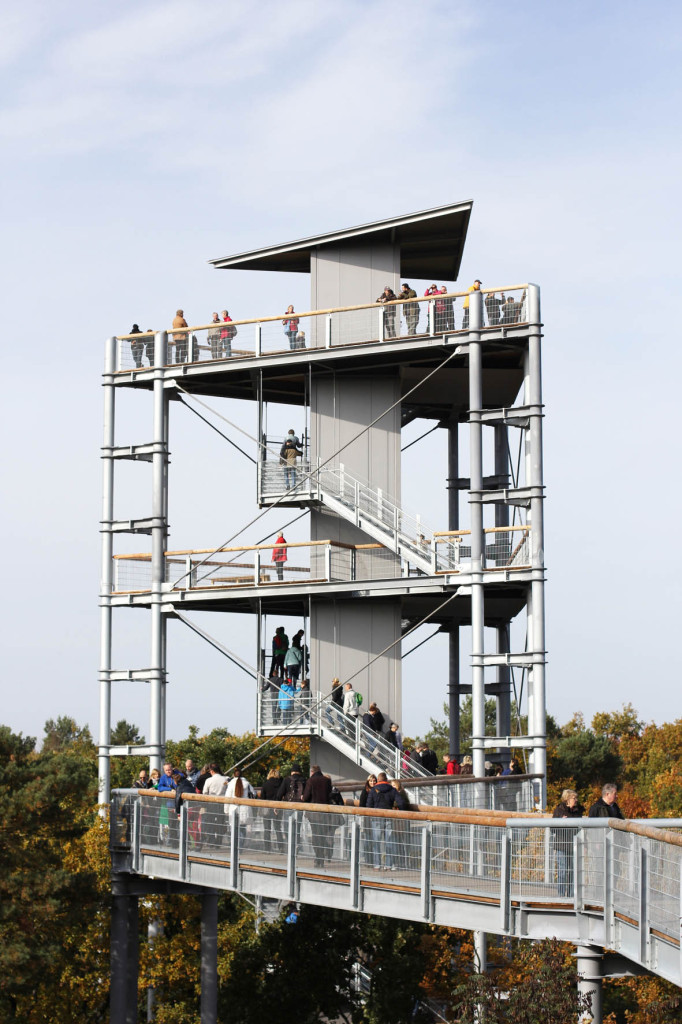
This is just the first incarnation of the Baumkronenpfad, which will in time be extended to 1000-metres.
I was taken aback by the length of the queue when I visited around noon this past Saturday, which meant a wait of about 15 minutes and the queue had more than doubled in length by the time I left about 2 hours later.
The combination of sunshine and the colourful leaves of trees displaying their autumn finery made for a spectacular sight.
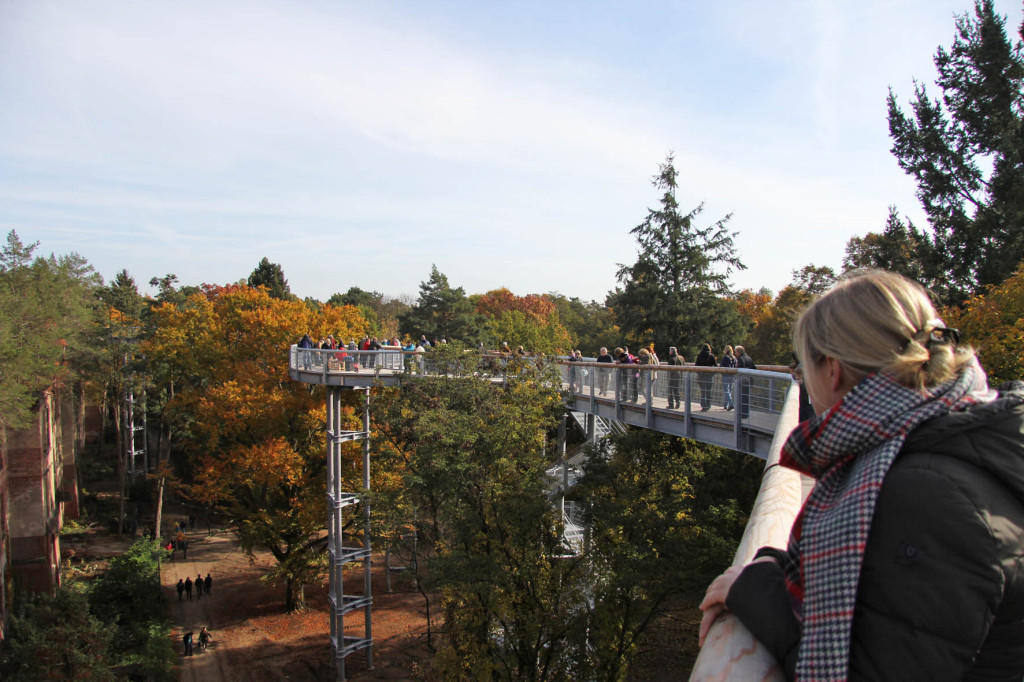
Entrance to the Baumkronenpfad costs 9.50 EUR for adults, 7.50 EUR for children aged 7-17 and is free for children up to 6 years old. As well as viewing the buildings from above a 1-hour tour including a history of the Beelitz-Heilstätten and a quick glimpse into the Surgery Pavilion is available for 4 EUR. Photo tours in the Alpenhaus and Surgery Pavilion with go2know cost 10 EUR per person.
You can check opening times, find directions from Berlin and get more information about the project on the Baum & Zeit Baumkronenpfad Beelitz-Heilstätten website and Facebook page .
- tweet
- share
You might be interested in
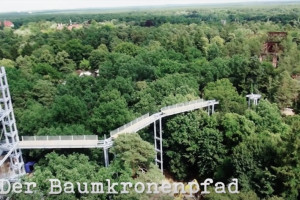
Baumkronenpfad Beelitz-Heilstätten , Beelitz , Beelitz-Heilstätten , Berlin , Treetop Walkway , Urbex
Trackbacks/Pingbacks
[…] The Baumkronenpfad Beelitz-Heilstätten, which includes a 36-metre high viewing platform and a 320-metre (with plans to extend to 1000 metres) long treetop walkway, opened at the beginning of September 2015 and you can see my impressions here. […]
[…] The Baumkronenpfad Beelitz-Heilstätten is a treetop walkway that winds its way for 320m over and around the abandoned sanatorium just outside Berlin. […]
Leave a Reply Click here to cancel reply.
Name (required)
Email (will not be published) (required)
By using this form you agree with the storage and handling of your data by this website. / Mit der Nutzung dieses Formulars erklärst du dich mit der Speicherung und Verarbeitung deiner Daten durch diese Website einverstanden. *

UEFA EURO 2024
All about the European Football Championship in Berlin
- Menu Berlin Welcome Card
- Menu Event calendar
- Menu Newsletter
- Contrast Contrast
Treetops at Beelitz Sanatorium
Guided tour.
If you've ever set foot on the grounds of the largely abandoned site of the Beelitz Sanatorium, you're familiar with its eerie charm. The buildings have been left to crumble slowly while the rambling old forested gardens take visitors back through the ups and downs of the 20th century. l
Image gallery

Ausflug in die Geschichte der Beelitzer Heilstätten
- Share on Facebook Share on Facebook
- Share on X Share on X
- Share by email Share by email
- Print page Print page
Stadt verhören. Mit dem Smartphone auf Spurensuche

Bärentouren: Crimetour


The Winding Trail
Adventures beyond the front door
Above the treetops – the Beelitz Sanatorium

The metal staircase starts at the bottom of the tower, and with each step we were climbing ever closer to the top of the trees. We were in the grounds of the old Beelitz Heilstätten, a sanatorium set among the pine forests south of Berlin. Looking up we could see the walkway stretching out from the tower, winding its way between the old sanatorium buildings and above the trees.
Our corner of Germany is pretty flat. It’s not always easy to get a view, to get a feel of the lie of the land. To get a sense of the scale of the forests that surround Berlin and stretch out in all directions. But at Beelitz there is a way, one step at a time up the metal staircase. And once up there it really felt like there was nothing around us but trees, and though we knew that somewhere out there were towns and villages, railway lines and motorways, it looked like the forest simply stretched out, unbroken, all the way to the horizon and beyond.

Since the treetop walkway opened in 2015, Beelitz has become a popular day trip destination for Berliners and others who live in the surrounding region. Before then, the Beelitz Heilstätten was the domain of urban explorers and others willing to jump the fence of the ruined tuberculosis clinic. They were drawn there, like many of the paying visitors today, to the strange beauty of the ruined buildings and the stories contained within their peeling walls; the strange fascination that many of us feel – known as Ruinenlust – for places of abandonment.
Beelitz was opened in 1898 and was one of the biggest tuberculosis clinics in Europe, a place where new treatments were developed in some of the most highly advanced medical facilities anywhere in the world. The clinic would continue in its important work until the end of the Second World War, where the complex was taken over by the Soviet military who remained in place until the Russian Army finally left in 1994.
Although the clinic’s buildings are landmark protected, twenty years of being abandoned to the forest have left their mark. Guided tours take visitors through some of the more structurally sound buildings, but even from the treetop walkway it is possible to gaze down and in through the open windows, to see rooms where rusting equipment shares space with scattered rubble and trees growing up through the floor, where Cyrillic graffiti left by the Soviet soldiers decorates the peeling walls and plants occupy the balconies where patients were once wheeled out to take the country air.

At the top of the tour we made our way along the walkway, looking down into the sanatorium buildings and out across the treetops to a horizon where it might be possible to spot some of the taller landmarks of Berlin in the distance. It may have been an entirely human-made structure amidst the ruins of an old hospital, but there was something about being up there that allowed us to understand a familiar landscape in a very different way.
Back down on the ground we followed a footpath through the woods, following in the footsteps of the patients, soldiers and urban explorers that had gone before us. As so often happens in a situation like this, the decades of being pretty much left alone have made the grounds of the Beelitz sanatorium unusual in a corner of Brandenburg known for its pine plantations with their uniform, straight lines of trees. Behind those high fences some 65 different tree and shrub species have been allowed to grow without hindrance, reminding us that so-called abandoned places are only ever abandoned in a certain way, and that they remain very much alive and occupied in another.

The path led us to a walkway next to the frame of a building, where women patients were once encouraged to take ‘air baths’ as part of their treatment. It made us think of the recent trend for ‘forest bathing’ – namely, going for a walk in the woods – and how each generation finds for itself the benefits of being out among the trees.
In Beelitz, at least, it felt like the forest had escaped the control of the plantations around. The old wards were embraced by the trees and the bushes, and even the structure of the treetop walkway seemed to be more part of the forest than imposed upon it. A place of abandonment had become a place of possibility. Of regrowth and return. To be viewed and understood from above the treetops, or down on the forest floor.

52°15’53.0″N 12°55’07.9″ Photographs: Katrin Schönig Words: Paul Scraton
Share this:

- Already have a WordPress.com account? Log in now.
- Subscribe Subscribed
- Copy shortlink
- Report this content
- View post in Reader
- Manage subscriptions
- Collapse this bar
Beelitz-Heilstätten Forest Park
Opening hours
Tel.: 033204–60580
Write e-mail
Arrival planner
Straße nach Fichtenwalde 13
14547 Beelitz-Heilstätten
Weather Today, 29. 6.
- Sunday 17 26
- Monday 13 19
Tourist information
Tourismusverband Fläming e.V.
Zum Bahnhof 9 14547 Beelitz
Tel.: +49 (0) 33204-62870 Fax: +49 (0) 33204-618761
- Write e-mail [email protected]
- To website http://www.reiseregion-flaeming.de/
All information, times and prices are regularly checked and updated. Nevertheless, we can not guarantee the accuracy of the data. We recommend that you inquire about the current status by phone / e-mail or via the provider's website before your visit.
Thank you for your enquiry!
In case your enquiry did not result in a booking, we will be getting in touch with you as quickly as possible during our service hours from Monday to Friday from 9 a.m. - 6 p.m.
We are also glad to answer all of your questions surrounding the State of Brandenburg at (+49)(0)331- 200 47 47. Please send us an e-mail at [email protected].
Your information and travel agency service Brandenburg
Your request was not successful!
Please try again later. Thank you.
Thank you for visiting www.brandenburg-tourism.com
This website has been developed with the latest technology. Unfortunately, you are using a browser that does not meet the latest technical requirements.
We therefore ask you to use an alternative browser (E.g. Google Chrome , Firefox or Edge ) and we hope you enjoy browsing our website.

15 Coolest Day Trips from Berlin in 2024
Who else is guilty of making the same New Years Resolutions every year? My resolutions come down to just a few things in essence: try to like running, consume less cheese, and finally become a grown-up. The fact that none of these things seem to ever happen is somehow reassuring (#foreveryoung).
This year I did try another resolution though: travel more within Germany .
For the past three years I’ve been feasting on this European buffet of fantastic countries, going to every place I had ever imagined. I’ve hit the big ones: France, Spain, Italy, England. I’ve hit some smaller ones too: Croatia, Denmark, Czech Republic. But the number of cities I’ve been to in Germany? I could count those on one lonely hand.
Luckily for anyone coming to Berlin and perusing this list, I didn’t get too ambitious with my Germany travel and instead have a bunch of amazing day trips from Berlin – most of which are within 2-3 hours of the city where you can go to unwind and take a break from the pervasive smell of Döner kebap.
You’ll find both Berlin excursions that get you into nature, as well as cities close to Berlin you can just enjoy for a different pace. I absolutely recommend adding a few day trips to your Berlin itinerary .
Are you sold? Let’s get started.
Best Berlin day trips
The easiest way to reach all of these places is by renting a car. Driving in Germany is much more straightforward than a lot of other European countries.
If you’re able to drive in Germany, I highly recommend DiscoverCars as someone who takes a lot of road trips in Europe.
Without further ado, here are the absolute best Berlin day trips I personally recommend, based on my experience living in the city for nearly 7 years.
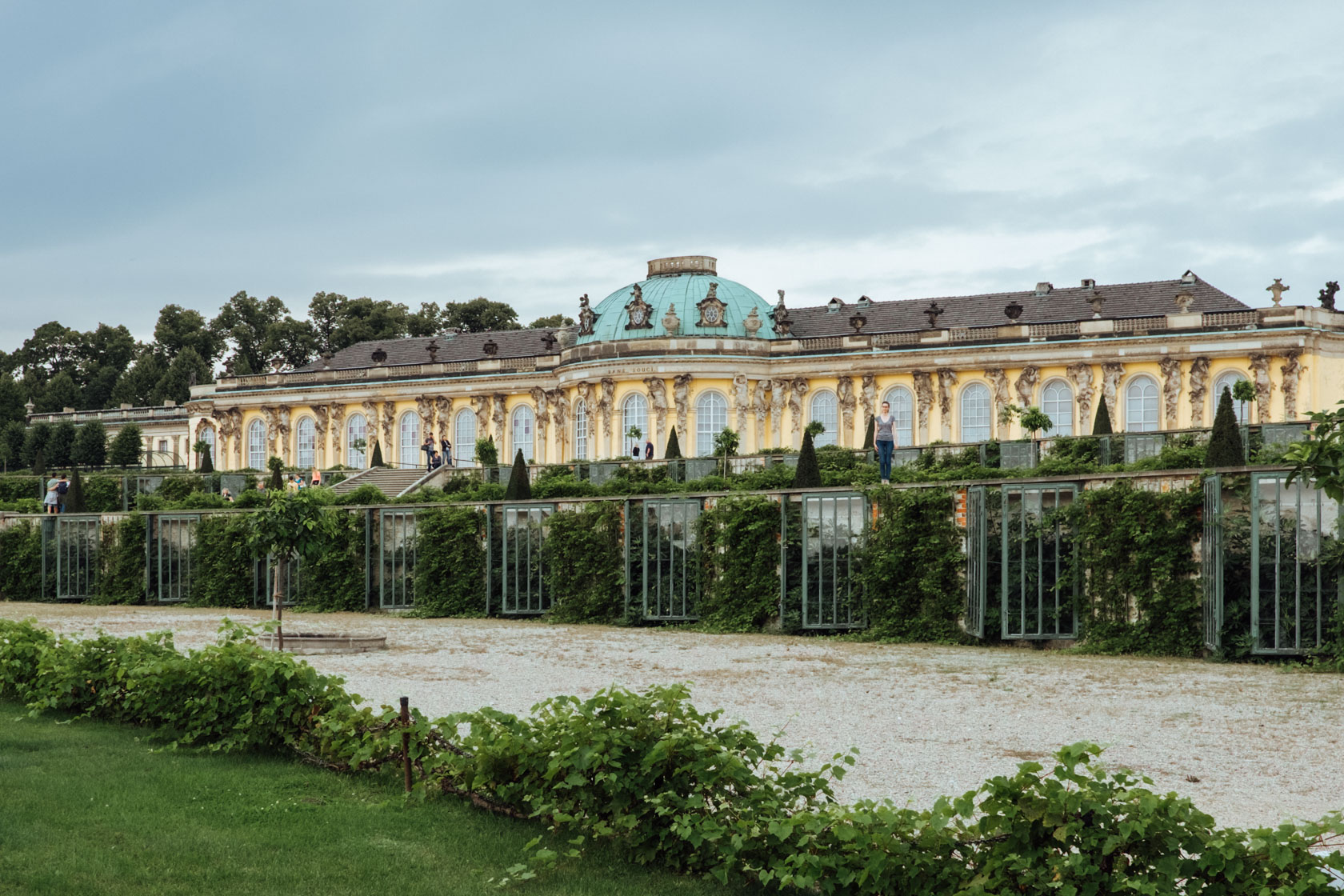
1. Potsdam and Sanssouci Palace (The Versailles of Germany)
- Distance: 36 kilometers (22 miles)
- Travel time: 1 hour each way
- Reach by: Tour or public transit
Potsdam is a posh town right outside of Berlin, charming and worth strolling through, however the main draw is undoubtedly the Schloss Sanssouci (Sanssouci Palace).
If you’ve been to Versailles during a trip to Paris, you might notice some similarities right away. Sanssouci has large, dedicated gardens, as well as smaller buildings along the grounds that you can go up into. The interior isn’t as vast, but the design of the palace rooms is just as elaborate and showy.
A stop in Potsdam and Sanssouci is easily the most popular Berlin day trip for first-time visitors to the city, and for a good reason. It’s beautiful, affordable, and easy to reach.
Especially if you’ve been to Versailles you’ll appreciate when I say this: comparatively few tourists visit Sanssouci. You don’t have to push your way through to see everything or fight people for a photo. Instead, it’s possible to just walk through, do some reading, and learn some history!
That said, buying tickets in advance is highly recommend during the high Summer tourism season to avoid waiting in a long line. Tips on that below.
How to reach Potsdam from Berlin
To reach Potsdam, take the S-Bahn (S7) to the Potsdam Hauptbahnhof (Postdam Main Station). Directly in front of the stations are busses that will connect you to the palace.
But as with most historical areas, it can be 10x more interesting when you have someone to explain the history to you. Personally, I’m so much more likely to actually remember things from a tour as opposed to passively reading signs inside the palace. This particular Potsdam + Sanssouci tour includes an English-speaking guide, tickets to the palace, and 1,000+ positive reviews.
2. Harz Mountains
- Distance: 239 kilometers to Wernigerode (142 miles)
- Travel time: 2.5 hours each way
- Reach by: Car
Germany’s Harz Mountains is a stunning forest region located 2.5-3 hours west of Berlin. Here you’ll find some of the best-preserved medieval towns in the entire country. But if you love nature, then waterfalls, forest hikes, traditional German food, and blissfully poor cell phone reception all await you in Harz .
But there’s something even more incredible about Harz you might not expect…
The absolute lack of foreign tourists. German travelers flock to Harz to get a taste of traditional Germany, see famous locations from Goethe’s Faust , and to fulfill the stereotype of being obsessed with hiking.
But apart from a healthy dose of Danes, Harz has completely flown under the international tourism radar. Which is a little surprising given how Instagram-worthy its towns full of Fachwerkhäuser (half-timbered houses) are.
Take, for example, a look at this sinister-looking Rathaus (town hall) in Wernigerode .
We spent an entire week in Harz and still ran out of time to do everything. In a leisurely day trip, you could definitely make it to Wernigerode to see the town hall (above), hike to the castle (first photo), and visit a traditional brewery. If you wake up early with a car, you could probably also add Goslar and Quedlinburg to your trip and visit all three major in a super packed day.
Read my dedicated Harz Mountains guide for details on the Harz National Park, the best towns to visit, where to stay in Harz, and how to extend your trip for a week or weekend.
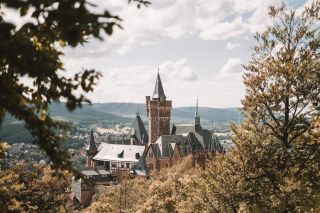
The Harz Mountains in Germany are a gorgeous highland area famous for forests, medieval towns, and witches of yore. Find out the best things to in Harz in this detailed travel guide.
How to get to Harz from Berlin
It’s best and fastest to get to Harz by car, which will shave 45 minutes off your arrival and departure trips. Plus, trains and busses in this region leave infrequently so this gives you much more flexibility.
It is possible to reach some of the main towns in Harz like Wernigerode , Goslar , and Quedlinburg by train in roughly 3 hours.
3. Saxon Switzerland
- Distance: 230 kilometers (142 miles)
- Travel time: 3 hours each way
Saxon Switzerland is a stunning national park and hilly region near the Elbe Valley, located about 230 kilometers southeast of Berlin. It’s one of the most beautiful places in East Germany, especially overlooking the Bastion Bridge ( Basteibrücke , shown above).
From Saxon Switzerland, you can also get sweeping views of the River Elbe . The most popular things to do in Saxon Switzerland include hiking, climbing, cycling, and visiting rock formations and vantage points beloved by landscape photographers. Perfect for either a single day or a weekend escape.
If you want to experience nature in Germany and take a break from the city, this is the best day trip from Berlin I can recommend to you. Here’s how to get there from Berlin.
How to reach Saxon Switzerland from Berlin
Reaching Saxon Switzerland from Berlin takes about 3 hours of travel each way, and is best done by car. Again, my recommended car rental company for Europe roadtrips is DiscoverCars .
Since Saxon Switzerland is a popular day trip for Berlin locals (especially during school holidays and weekends) visit during the week when possible.
4. Spreewald
- Distance: 100 kilometers (62 miles)
- Travel time: 1 hour 20 minutes
- Reach by: Car or train
Spreewald is a UNESCO-designated biosphere reserve located just 100 kilometers outside of Berlin in the state of Brandenburg. It features over 200 canals you can navigate by kayak, canoe, or a traditional punting boat (called Spreewaldkahn ) for a total of 276 kilometers.
Besides being able to paddle around, you’ll also get a glimpse into the traditional Sorbian village of Lehde . This region was originally settled by the Sorbs and Wends, who came here over 1,400 years ago from the Carpathian mountains. In fact, the word “Berlin” originally comes from the Slavic word for “swamp”!
Spreewald is a gorgeous day trip from Berlin in any season, but Summer and Autumn are especially beautiful. It’s also a great example of local tourism, as you’ll find very few other foreigners here.
How to reach Spreewald from Berlin
The most efficient way to reach Spreewald from Berlin is by renting a car. Again, DiscoverCars is my go-to. Otherwise, it is possible to reach Spreewald by train from Berlin by disembarking at the Lübbenau/Spreewald stop.
Read my dedicated guide to Spreewald, Germany for more details on visiting this gorgeous forest in Brandenburg, and things to do in the area.
- Distance: 55 kilometers (34 miles)
- Travel time: 1 hour by car or train
Are you into so-called “Dark Tourism”? Beelitz is a former Sanatorium, now completely dilapidated and overgrown with trees. Today, you can walk through the canopy on a treetop walk, called the Beelitz Baumkronenpfad (“Beelitz Canopy Path”).
Some say the hospital ruins are haunted, and when you take a tour through the parts of it that are still accessible, you might get an idea why. It was originally built to treat tuberculosis patients en mass , before being repurposed as a military hospital to treat Nazis during World War II and Soviet soldiers until the 1990s. You can go inside some parts of the former hospital today on a guided tour:
Most famously, some World War II-era scenes from The Pianist were shot at Beelitz. It was also featured in a Rammstein music video. If you like visiting abandoned places and learning about their history — or just think the treetop walk looks awesome — make your way to Beelitz.
How to reach Beelitz Sanatorium
The easiest way to reach Beelitz is by car, and takes just one hour of driving. There’s a lot of parking at Beelitz, as the Sanatorium and Treetop Walk has been converted into a proper attraction with tours (including in English) and food stalls. Car is how we reached Beelitz ourselves.
It’s also possible to reach Beelitz by train, as there is a train station right at Beelitz-Heilstätten . From Alexanderplatz, it takes about 1 hour to get there.
- Distance: 190 kilometers (118 miles)
- Travel time: 90 minutes by express train, 2.5 hours by car
- Best reached by: Car or train, but bus is also possible
Looking for an off-beat city trip? Leipzig is your answer. Just a 90-minute train ride from Berlin, and you’re in a place that the New York Times won’t stop calling “The New Berlin”.
As someone who used to live in Leipzig, I disagree. But that doesn’t mean it’s not a great city.
Leipzig is hip, it’s cheap, and it’s a little bit like what Berlin must’ve been like 15-20 years ago. Leipzig used to be one of the biggest cities in East Germany before the wall came down, but saw a mass exodus of people when the country was reunited. That’s why real estate prices are low, there are a lot of abandoned buildings, and the city has struggled to recover to its former glory.
That said, Leipzig has a lot to offer in a small, concentrated package, so it makes for a wonderful Berlin day trip.
What makes Leipzig unique? Leipzig, in some ways, is like a time capsule. Although the city is modernizing, demolishing, and rebuilding, the city’s architecture is distinctly East German. Combine that with the youth and university culture, Leipzig is a place where you can have a good time on little money without having to go far.
Best things to do in Leipzig
Of course I have to turn this into a blog post at some point, but here’s a quick rundown of the things I would say are essential for having a city trip in Leipzig.
- Visit the Christmas market – Leipzig has one of the most charming Christmas markets I’ve ever visited, and it happens right in the middle of the car-free city center.
- Go for a walk through Clara-Zetkin Park – If you look on a map, you might be shocked to see exactly what the relative size of this park is to the rest of the city. In the summer, people gather on the Sachsenbrücke to drink beer al fresco and create live music.
- Check if you’re in town for the Bier Börse , an annual beer festival. You’ll get to try a variety of German beers (and beers from the Czech Republic, Belgium, pretty much anywhere in Europe that’s known for beer).
- Take a walk through the city center and absorb the main sights : Augustusplatz, Leipzig Opera, Thomaskirche (where Bach is NOT buried, but they say he is). There’s a local brewery near the Thomaskirche which always has a different seasonal beer on tap.
- Spend an afternoon in trendy Plagwitz, a neighborhood west of the center. Here you’ll find the Baumwollespinnerei , a former textile factory turned into art exhibits. There’s a lovely beer garden, as well as an fabulous art store (where only university students and “unknowing tourists” can shop), great for gifts.
- Visit the Völkerschlachtdenkmal (Monument to the Battle of Nations), which is pictured above. It celebrates the fact that Napoleon was defeated at Leipzig in a big way. Fun fact: This is where the Backstreet Boys performed when they visited Leipzig.
- Go for a beer my favorite beer garden in all of Germany : Substanz in Reudnitz, the district best known for student life. The best time to go is when the beer garden is open from late Spring through early Autumn. If you can’t make it, there’s still the piano bar. The burgers are divine.
Restaurant recommendation in the city center: Imperii
How to reach Leipzig from Berlin
There’s a train between the two cities that runs every hour between main stations – you can decide between a fast train and a slow train. 1 hour 45 minutes). These trains are possible to book directly in the station, although you will save some money by booking in advance. Booking the same day means the trip costs about 50 EUR, and in advance can bring it down to half that.
Besides trains, you can take a bus between Berlin and Leipzig , which will run you between 10-20 EUR. The most comfortable option of all would be booking the express train (ICE) far enough in advance.
7. Bad Muskau
- Distance: 163 kilometers (101 miles)
- Travel time: 2 hours by car
Bad Muskau is home to the Muskau Park, officially called the Fürst-Pückler-Park Bad Muskau . It’s one Central Europe’s largest and most famous gardens. This town is right on the border to Poland if you want to easily add another country to your own personal count. The Muskau Park was added to the list of UNESCO World Heritage Sites in 2004.
Today you can go to the Museum, walk around the gardens, go to the cafe, and have a picnic. Bad Muskau is just down the street from Kromlau Park (listed below) so if you’re going to one, it makes sense to combine them for a day trip.
How to reach Bad Muskau
Drive southeast from Berlin for about 2 hours along the A13 and then the A15. You’ll basically follow the signs to Cottbus for most of the way, and will drive right through Spreewald as you do. Trying to do this trip by train would take 12+ hours, so if you want to see this area, coming by car is virtually your only option.
8. Germany’s Devil’s Bridge in Kromlau
Kromlau is a small town on the border between Germany and Poland, and Kromlauer Park is a hidden gem, visited by a very small number of foreign tourists.
This 200-acre park is home to the Rakotzbrücke, also called Germany’s Devil’s Bridge for the legend behind it that the devil helped build it in exchange for the first living soul to cross it once completed. In Autumn, this park is absolutely breathtaking, although lacking a lot of the flowers and ponds that would otherwise be there in Spring.
What makes Kromlau unique? It’s not a city, it’s not on any major tourism website – it’s a local sanctuary that few find out about. If you want to see something in Germany that few others have, Kromlau is waiting for you!
How to reach Germany’s Devil’s Bridge from Berlin
The trip can be a half-day trip if you’re going by car, but will most likely require a full day if you’re going to take public transit. By car, you’ll start driving towards Dresden, and then towards Cottbus as soon as you see signs for it. By public transit, you’ll take the train to Cottbus and then transfer to an old steam train to make it into Kromlau.

This legendary bridge in Saxony, Germany will make you feel like you've fallen into a fairytale. It's one of those places where it's just as magical in photos as it is in real life.
- Distance: 26 kilometers (16 miles)
- Travel time: 50 minutes
- Reach by: Car or S-Bahn
Wannsee has a dark history behind it, but nonetheless is a beautiful area to visit from Berlin. Nowadays, people mostly come to Wannsee to visit the lake, which is one of the most popular sandy beaches surrounding the city. On a hot day it can get crowded, but there’s plenty of beer and beach food to keep you comfortable.
Wannsee is most famous for being the site of the Wannsee Conference, where senior Nazi officials met to plan the Final Solution to the “Jewish Question”. The location of this meeting, the Wannsee Villa, has been converted into a free exhibition where you can read real clipping from the newspapers and internal documents alike, demonstrating how the Jews were targeted and blamed for Germany’s problems. Honestly it’s unsettling to be in the same building where this happened, but seeing the original words of the people involved is eye-opening nonetheless.
What makes Wannsee unique? I’d say the fact that you can have a really balance day of learning about history, and then relaxing on the lake. Neither has to be a full-day activity, so there’s some real variety to this day trip.
Quick tips for visiting Wannsee:
- The Haus der Wannsee-Konferenz (House of the Wannsee Conference) is a free exhibit, where you’ll pass through several rooms, all overlooking the beautiful Wannsee .
- Another villa, the Liebermann Villa , hosts artist Max Libermann’s paintings of his home and garden. Unlike the Wannsee villa, it is not free to enter.
- Pfaueninsel is a nearby nature reserve, which tops numerous other lists of best day trips from Berlin. I went last Summer and it was a really nice trip to enjoy some of the nature around Berlin.

Pfaueninsel, as it's called in German, is home to a charming Prussian castle and only a short S-bahn ride outside of Berlin. Here are things to do on Pfaueninsel and how to get here!
How to reach Wannsee
You’ll take the S-Bahn S1 line, which passes through major stations throughout Berlin such as Potsdamer Platz, Brandenburger Tor, and Friedrichstraße. The S7 line is also an option, which passes through Alexanderplatz, Hackescher Markt, and Hauptbahnhof (Berlin main station).
10. Britzer Garten (in Spring)
- Distance: 12 kilometers (7.4 miles)
- Travel time: 45-60 minutes
Germans love nature, and nature loves the Germans – nowhere is it clearer than Britzer Garten, a large park featuring a lake, rose, tulip, and dahlia gardens, a functioning windmill, and a Liebesinsel (Love Island). Both dogs and bicycles are banned in this park, so it’s guaranteed to be peaceful. There’s a cafe overlooking the lake, as well as convenient spot for ice cream.
Come here if you’re looking for an early taste of Spring – when everything else is still waking up from their winter’s sleep, the cherry blossoms at Britzer Garten are already showing off how pretty they are.

You don't have to go to Japan to experience cherry blossom season. Berlin has over two kilometers of cherry blossoms waiting to be wandered through, admired, and photographed! Here are the best places in Berlin to enjoy cherry blossoms.
When we came to Britzer Garten, we packed for a picnic and ate right across from the Love Island. Everything was fine and dandy until a swan decided he wanted to share our meal! I pretty much thought he was going to fight us, but somehow we managed to defend our food.
What makes Britzer Garten unique? Like Kromlauer Park, Britzer Garten is a place enjoyed mostly by locals who are looking for some time out of the city. You’re unlikely to get stuck behind hoards of tourists trying to snap an identical photo – you can just come here to wind down in the middle of a busy tour through Germany.
How to get to Britzer Garten. You can take the U6 U-Bahn south in the direction of Alt-Mariendorf. From there, transfer to the 179 Bus towards Gerlinger Str. and disembark at Sangerhauser Weg. A short walk (6 min, 550 meter) down the same road and you’re there!
11. Müggelsee
- Distance: 21 kilometers (13 miles)
- Travel time: 50 minutes by S-bahn from Alexanderplatz
- Reach by: S-bahn
Berlin is surrounded by countless lakes, and if you come in Summer on a weekend, you’ll see the public transit full of people who are clearly heading for a day at the beach. Müggelsee is one of the most popular lakes in Berlin, given its shallow waters make it one of the warmer options. You can bring your family or set up solo. There are some snacks available at the lake (for a premium) or bring your own food and drinks.
How to get to Müggelsee. The easiest way to get to Müggelsee is to take the S-bahn (S3) to Köpenick and then ride your bicycle around the lake. Otherwise at Köpenick you can connect to a bus that will take you closer to the lake. All in all the trip takes between 50-80 minutes depending on where you’re starting in the city.

12. Wittenberg
- Distance: 112 kilometers (69 miles)
- Travel time: 90 minutes by car, 1 hour 40 minutes by train
If you learned about the Protestant Reformation in school, there’s a good chance you’re familiar with Wittenberg’s most famous resident: Martin Luther. It was in Wittenberg that he nailed the 95 theses to the door of the church, and if you come here you can see the exact door that he nailed it on.
The city isn’t huge but you can come by and explore some small shops, get an ice cream, and give yourself a small historical tour. Near the church there is also a museum about Martin Luther and the protestant reformation.
How to get to Wittenberg
You can simply book a train directly from Berlin to Wittenberg, or opt for renting a car if you prefer. You can book a train on the Deutsche Bahn English website .
- Distance: 349 kilometers (216 miles)
- Travel time: 4 hours by car, 4.5 hours by train
It’s arguably a stretch to call Prague a day trip, but if you really want to see Prague from Berlin it’s doable. You need to get up early, and you need to come back late, but it can be done! I’ve done it as a day trip from Leipzig before.
Plus, the Czech Republic is probably the easiest of all the countries near Berlin, Germany to visit.
Prague may be one of the most popular cities with tourists coming to Europe and it’s no surprise why – the architecture is beautiful, the prices are still rather low, and there is a ton of things to do in this historic city.
How to reach Prague from Berlin
In the interest of time, the best way to get here is by car. It’s also possible to take a train which will add an hour on to your travel time, or even to take a six hour bus. At six hours I would argue it’s easier (and probably costs just as much) to take a plane!
14. Hamburg
- Distance: 289 kilometers (179 miles)
- Travel time: 2 hours by express train, 4 hours by car
I’ve only been to Hamburg once in the dead of Winter and it was cold and dreadful. But in the Summer, Hamburg is known to be one of the prettiest cities to visit in Germany. It’s a port town, with nautical vibes up and down. You can take a walk along the sea, participate in its famous nightclub scene, or infamous Reeperbahn.
How to get to Hamburg. Trains run regularly from Berlin to Hamburg, so you’ll have no issue booking one with Deutsche Bahn. If you prefer you can also go by bus via Flixbus, but it will take much longer.
15. Dresden
- Distance: 193 kilometers (119 miles)
- Travel time: 2 hours 25 minutes by car or train
I have to admit – I’ve never been to Dresden! I’ve always wanted to go but never quite made the time. Which is a shame because it’s so close to Berlin and is meant to be very beautiful. You can spend a weekend here and enjoy the history of the city, which came under heavy fire during the second world war. Today you can visit the reconstructed version of Dresden’s most famous sight, the Frauenkirche (Church of our Dear Lady).
How to get to Dresden. Similarly to Hamburg, there are plenty of regular trains at your disposal as well as bus service. Dresden is close to Saxon Switzerland so if you’d like, you can combine these trips into one.
Have you ever been to these cities and towns outside of Berlin?
What’s your favorite daytrip you’ve even taken outside of a major city? For me, Kromlau is my absolute favorite out of Berlin (although Leipzig might contend if I were truly a first-time visitor). Versailles was also cool, but way too crowded! Let me know what your favorites are in the comments!
Like this post? Pin it for later!

About the author
Hi there! I'm Monica, an American expat living in Germany for over six years and using every opportunity to explore the world from my homebase in Berlin. My goal is to capture my memories in photos and posts that show how easy it is to start from scratch and travel the world by working abroad.
Follow along on Instagram , Twitter , Bloglovin , & Facebook .
You might also like...

Berlin's Best Local Restaurants with Delivery in 2022

Locals Guide: Where to Stay in Berlin, Germany

7 Best Berlin Christmas Markets (UPDATED 2021)

Beelitz Sanatorium – Hospital and Creepy Place

- Gepostet am 29. March 2021
- last updated 5. August 2022
- , in: East Germany
Table of content
In the Berlin area and in Brandenburg , the small town of Beelitz, located about 60 kilometers southwest of Berlin’s city center and 30 kilometers southwest of Potsdam , is ubiquitous: asparagus from Beelitz is considered a high-quality delicacy that is aggressively advertised in grocery stores and street markets in the spring. Less well known is the huge area of the former Beelitz Sanatorium with its more than 60 buildings, covering more than 200 hectares. We want to explore this “lost place” together in this article.
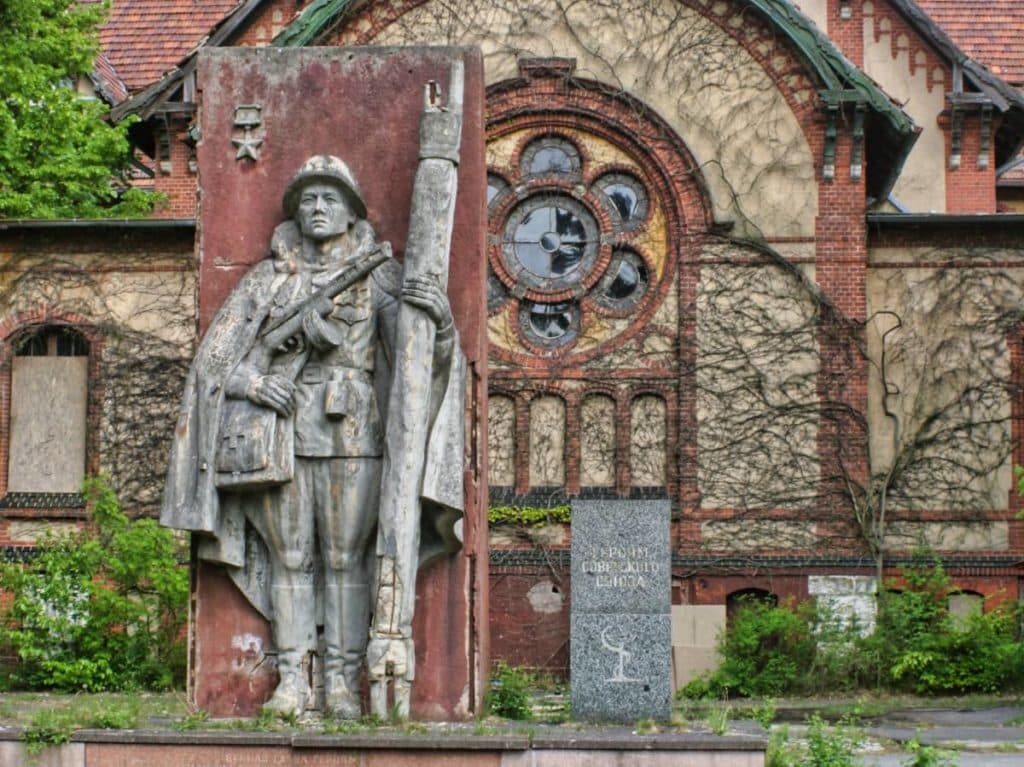
The eventful history of the Beelitz sanatorium
To examine the beginnings of Germany’s largest pulmonary hospital, we have to travel back in time 130, 140 years. In the late 19th century, German industry was booming and hundreds of thousands of workers and their families were living together in cramped quarters in the metropolises. The catastrophic hygienic conditions were breeding grounds for infectious diseases that were killing people in large numbers. In particular, tuberculosis, a disease that mostly affected the lungs, was widespread and the most common cause of death in the German Reich in the age group between 15 and 40. At that time, the best remedy against the insidious disease was recommended to be the prolonged inhalation of fresh, clean forest air.

The Establishment of the Beelitz Sanatorium
For this reason, starting in 1898, a sanatorium was built in the remote pine forests of Beelitz on behalf of the Berlin State Insurance Institute, which admitted patients for the first time in 1902. The bed capacity was even doubled a few years later from 600 to 1200. A train line connected the pulmonary sanatorium, which was supplied with electricity and heat by a specially built power plant, with the metropolis of Berlin, which had millions of inhabitants.
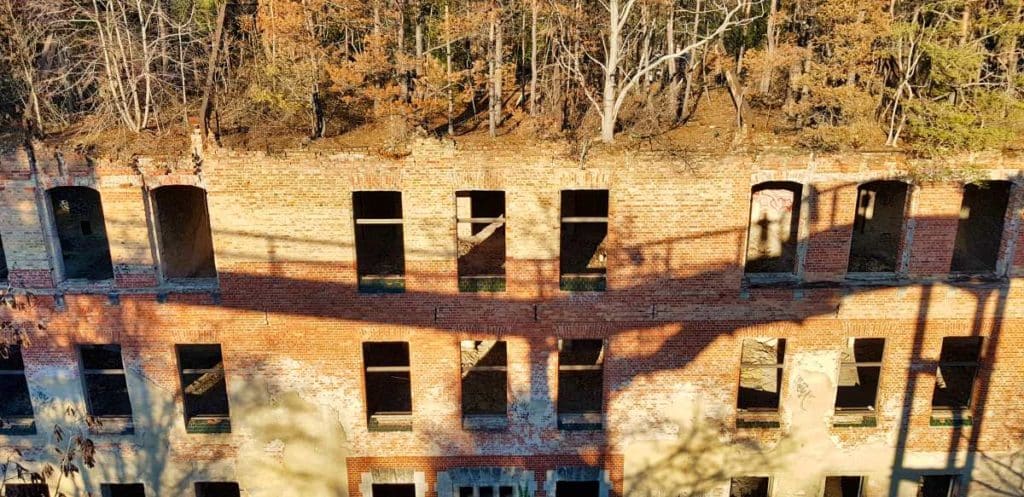
In order to satisfy the prevailing moral ideas of Wilhelmine Germany at the time, men and women were housed in strictly separate areas in the Beelitz sanatorium. There was a further division between infectious and noninfectious patients. In addition to other treatments, extensive walks in the forest and park areas or hours of lying in the largely dust-free fresh air provided relief and healing. On postcards, patients proudly reported their recovery process to their relatives: “Minna, I’ve already gained three pounds!”
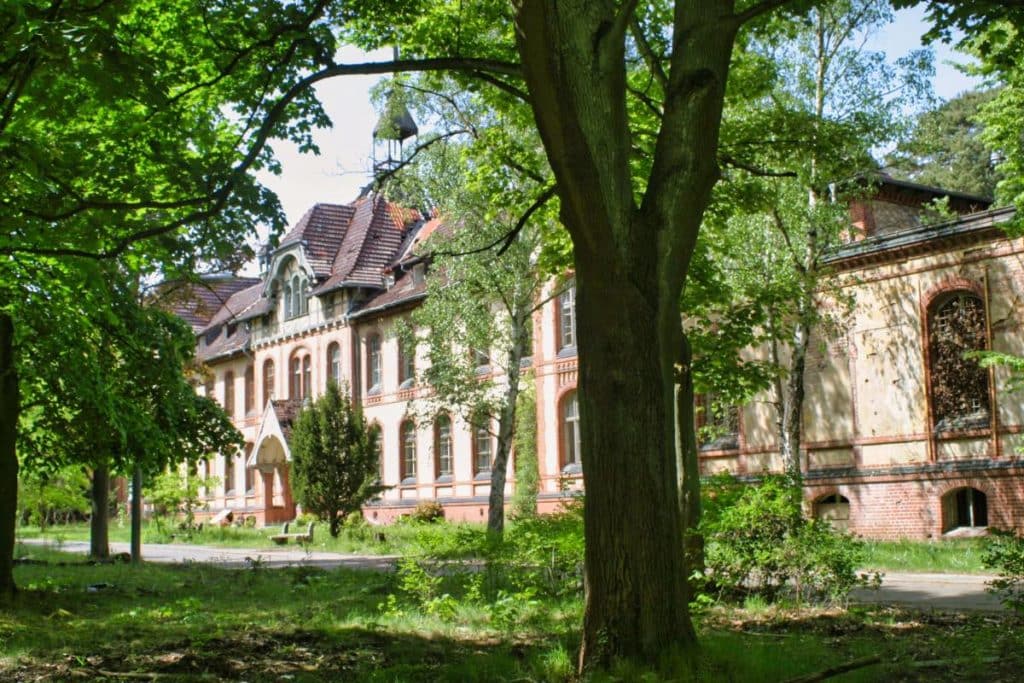
Short-term transformation into a military hospital
In the fall of 1914, however, the hospital idyll in the sand of the Mark Brandenburg was over: instead of sick, haggard city dwellers, wounded soldiers were now forced to lie in the beds. The First World War had begun and the priorities were suddenly different. The field-grey uniforms were to recover quickly in order to be able to risk their lives again at the front. Over 12,000 soldiers were admitted here during the four years of the war. Among them was the simple private Adolf Hitler, who was treated in Beelitz for two months after being wounded in the fall of 1916.

In the 1920s, however, the Beelitz sanatorium once again focused on TB patients and demand exceeded supply. For this reason, capacities were again expanded in a third construction phase from 1926 to 1930. And these additional beds were also urgently needed from 1939, when the Beelitz sanatorium once again functioned as a military hospital. At the end of April 1945, Beelitz even became a theater of war during the Soviet attack on the Reich capital. Scattered German army units disbanded the military hospital and most of the approximately 3,000 patients were able to escape to the west with the help of the Wehrmacht to avoid capture by the Red Army.
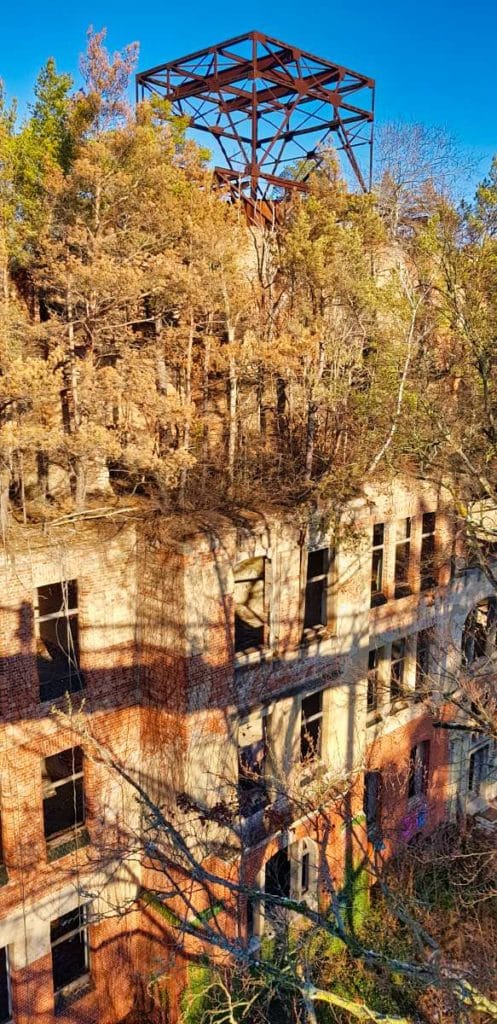
Takeover by the Soviets
Although the sanatoriums had been partially destroyed by air raids and the fighting of April 1945, the Soviet military took over the hospital, repaired it, and henceforth used it for its soldiers. For almost fifty years, from 1945 to 1994, it would function as the largest Soviet hospital complex outside the Soviet Union.
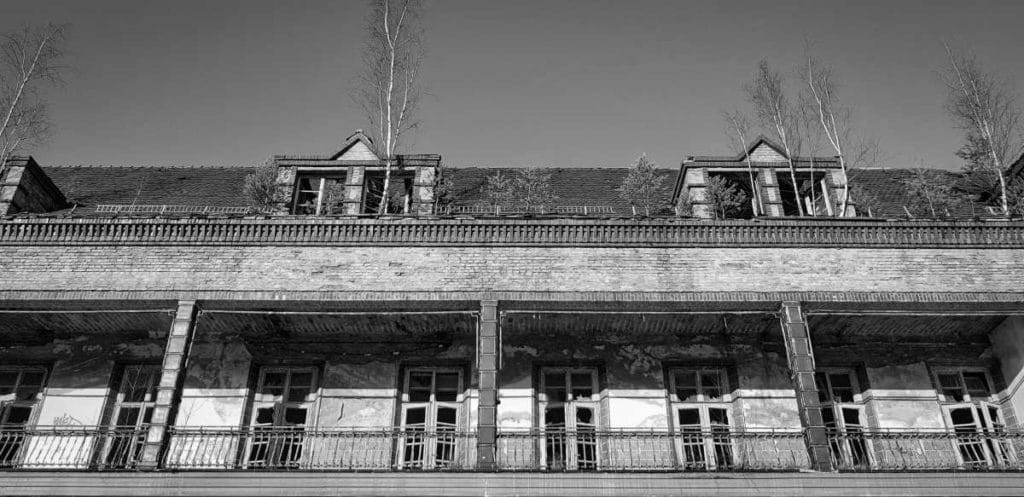
Honecker in Beelitz
However, the Beelitz Heilstätten only came to the attention of the world public after the collapse of the GDR. In the confused turnaround months after the fall of the Berlin Wall, the Beelitz Military Hospital, whose grounds enjoyed extraterritorial status – comparable to an embassy – hosted one of its most famous patients. The deposed former head of state of the GDR, Erich Honecker, was treated here for cancer. Honecker, who was charged with various crimes, thus evaded the grasp of the investigating authorities. After almost a year’s stay in Beelitz, the Soviets airlifted Honecker and his wife Margot to Moscow on a military jet in March 1991. Only three years later, with the withdrawal of the last Soviet/Russian troops from the eastern part of reunified Germany, this chapter of the Beelitz sanatoriums also ended.
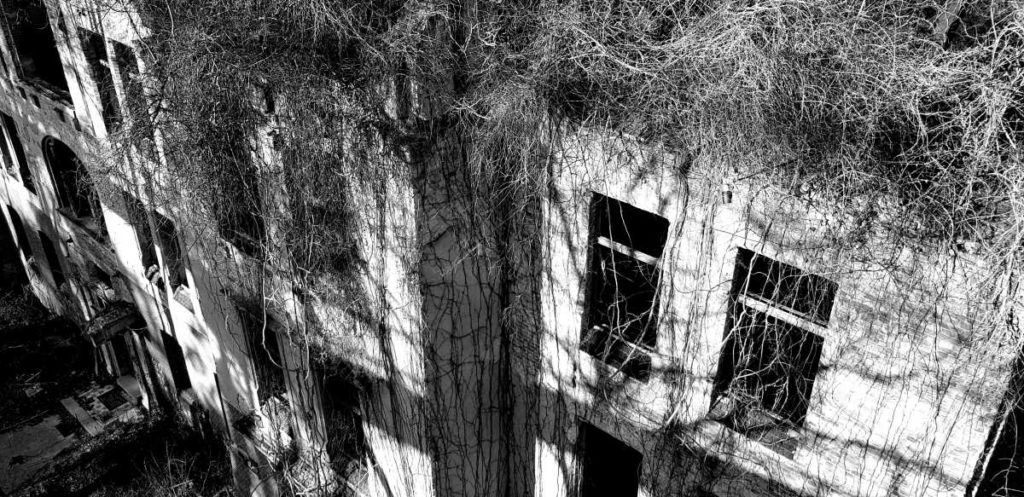
The Beast of Beelitz
After the Russian departure, a long period of oblivion and decay began for the old hospital area Beelitz Heilstätten. Unclear ownership, changing investors, and the Beeltiz Sanatorium’s gloomy atmosphere caused the buildings to decay into ruins and become a popular creepy spot in the Satanist and Goth scene. The morbid charm and eerie ruin aesthetics were further underpinned by a gruesome real-life crime. In March 1991, a young mother and her newborn child fell victim to a bestial murder just a few meters outside the clinic grounds.
The brutal execution of the crime resembled the modus operandi of a serial killer who had been making the region unsafe since the fall of 1989: the “Beast of Beelitz” (“German: Bestie von Beelitz) as the tabloids luridly dubbed the murderer, had struck again. It was not until August 1991 that he could be overpowered by two joggers who had noticed a 1.90 m man masturbating in a patch of woods in pink women’s underwear. The lust killer Wolfgang Schmidt, who became Beate Schmidt in custody, killed a total of six people and is still in prison today.
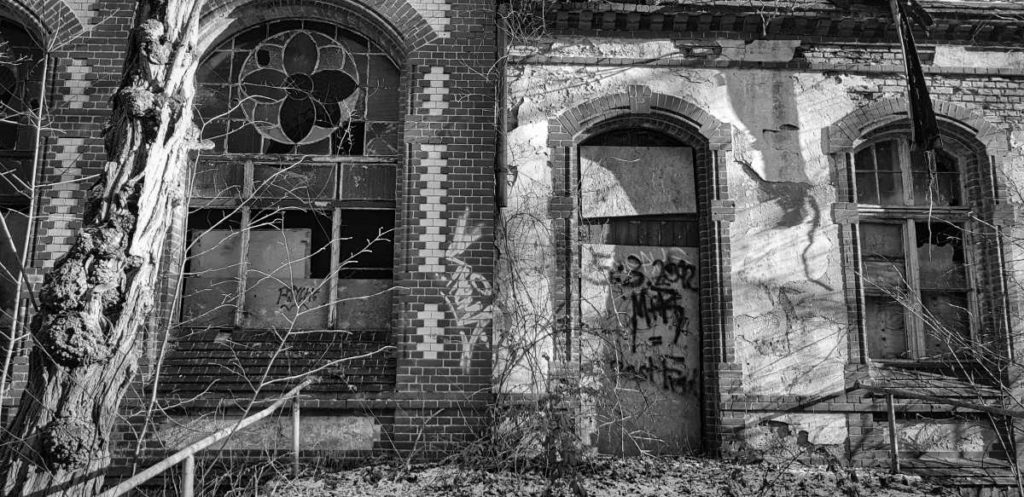
Another murder
In the new century, the former lung sanatorium of the Beelitz Heilstätten was once again the focus of public attention. After an erotic photo session in the dilapidated premises, another young woman lost her life. One of the photographers, a paleontologist with a doctorate from southern Germany, took the 20-year-old model to his pension in Beelitz. There – according to the statement of the hobby photographer – during sado-masochistic sex games an unintentional accident happened. However, forensic examinations and photos from the accused’s camera clearly pointed to a premeditated act and the dinosaur researcher was sentenced to many years in a psychiatric hospital.
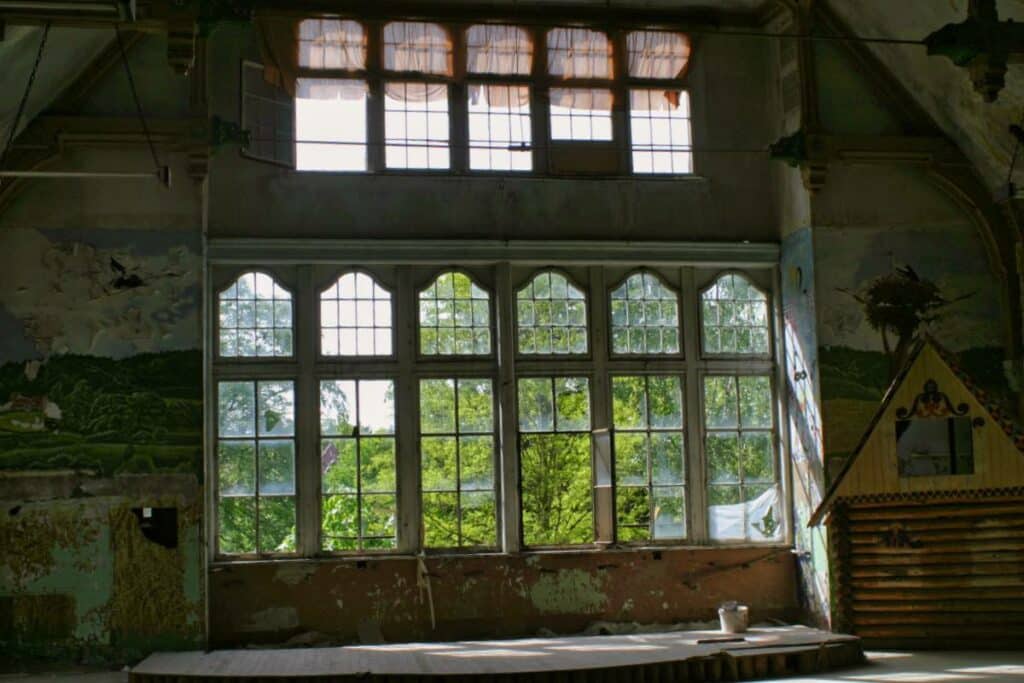
Unwanted guests
As a result, “dark tourism” continued to grow, even though it had long been forbidden to enter the Beelitz Heilstätten. In relevant Internet forums, followers of occult rites fantasized about the souls of the deceased wandering through the buildings at night. The illegal visitors, whether Satanists, photographers in search of morbid motifs, or teenagers who just wanted to get really spooked at night, became more numerous. Several of these mostly nocturnal excursions ended with accidents in the dilapidated legacies, serious injuries and another death: a 25-year-old man died in 2010, a few days after falling out of a window on the fourth floor, in hospital in Berlin.
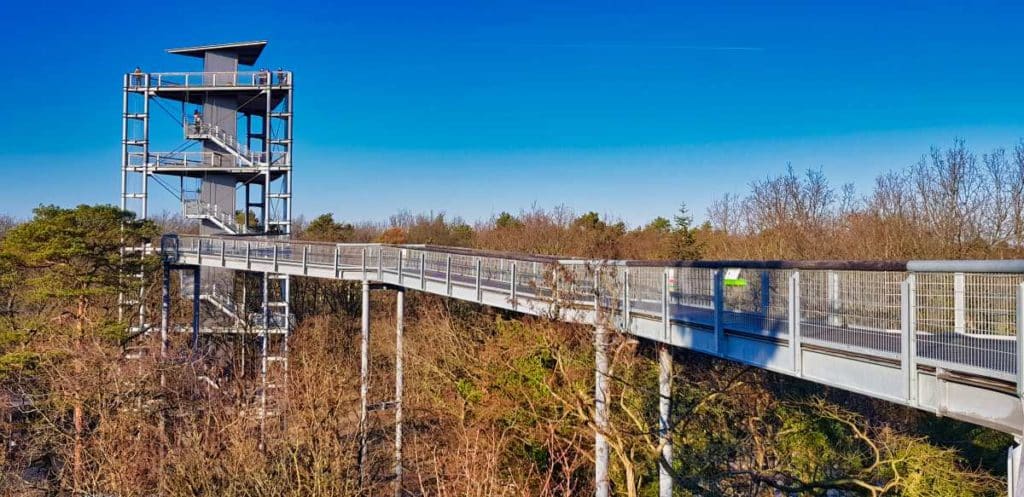
The Beelitz sanatorium today – Walking the treetop trail
It was not until 2015, after various failed attempts at revitalization, that sustainable movement slowly came into the future design of the listed sanatoriums. A tourism concept for future visitors, but also an economic use of the area with residential development and partial reuse of the premises was concretized. In the same year, the spectacular treetop path, which leads at a good 20 meters above a part of the ex-clinic, was ceremonially opened.
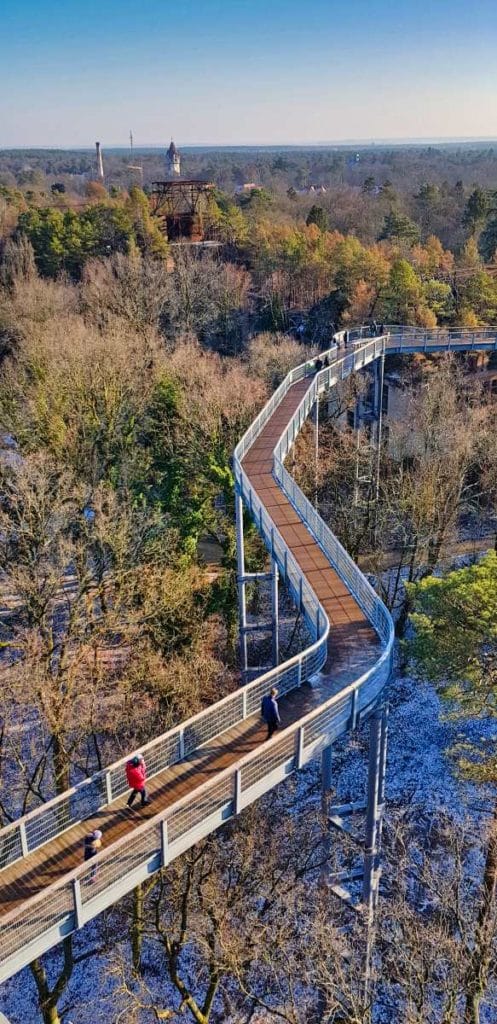
After the expansion of the trail in the summer of 2020, it now measures a total length of over 700 m and features attractions such as the giant hammock, the climbing snake “Sky Boa” designed for children or the “Goosebumps Bridge”. Information on opening hours and admission prices can be found here .
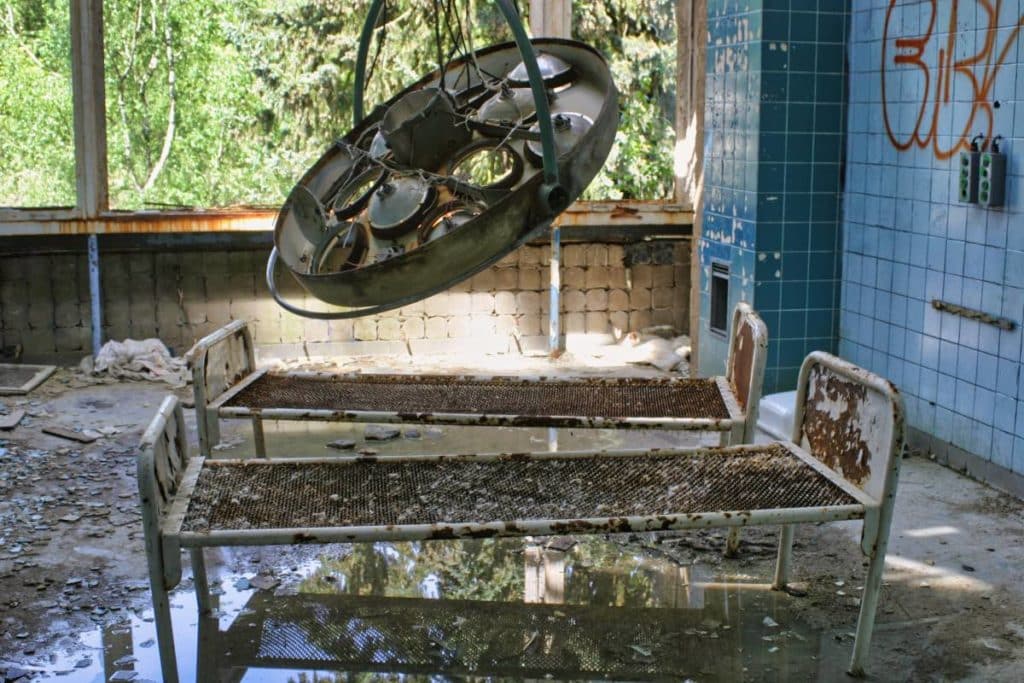
Guided tours
The buildings, some of which are very dilapidated – such as the surgery or the Alpenhaus with its wooded roof – can only be visited on organized tours for safety reasons. You will get an insight into what the rooms of the sanatoriums once looked like from the inside. The guides will show you photos of the former use. Inside you can also see what the buildings looked like during the Soviet era. There are also attractive thematic tours specially designed for (amateur) photographers.
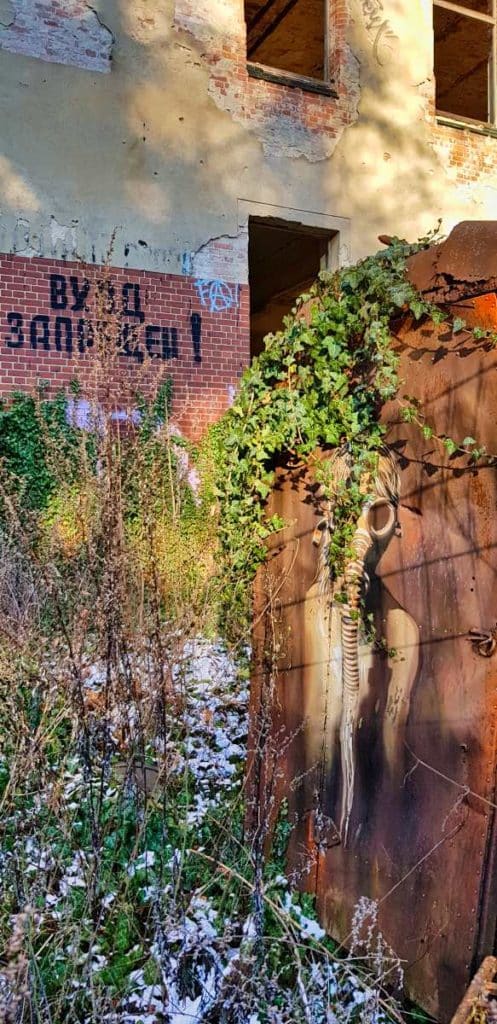
Barefoot Park
And if the dilapidated ruins don’t appeal to you, or if you’re in the mood for something “non-historical,” you’ll find an alternative activity in the immediate vicinity. In the barefoot park – nomen est omen – you can experience the fascination of “walking without shoes”. On four color-coded circuits, you can get closer to various natural surfaces than ever before. In addition, the otherwise always well-soled city dweller can discover that calluses under the feet can definitely have their raison d’être! Details about the barefoot park are available here .
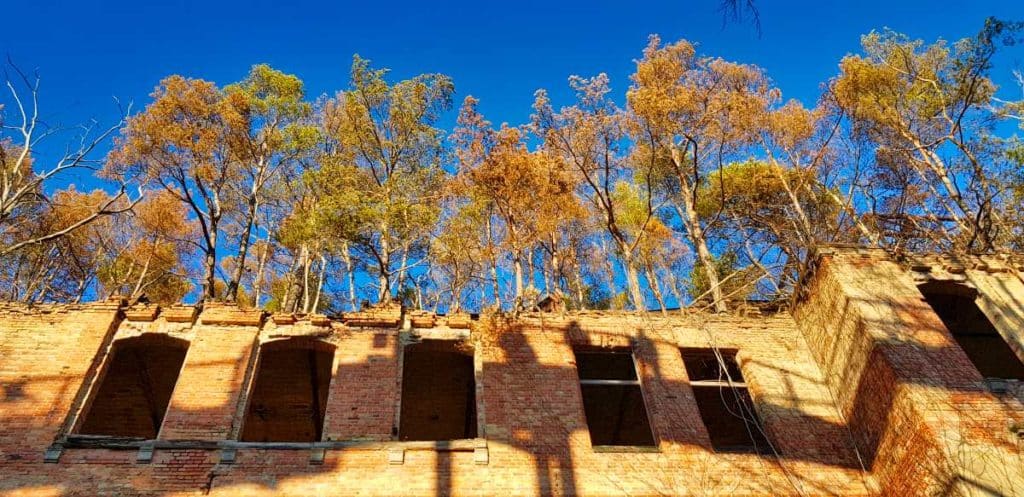
Getting to Beelitz
The Heilstätten Beelitz are definitely one of the most attractive and multifaceted excursion destinations in the Berlin area. By car, you can reach Beelitz via the A10/9 in about 45 minutes from Berlin city center. An excellent alternative is also the regional express (RE 7) from Berlin Hauptbahnhof, which takes 42 minutes. The destination station Beelitz Heilstätten was, interesting historical side note, signposted in German and Russian until 1994: Вокзал Белитц-Хайльштеттен.
Book recommendations
Had enough of Beelitz? Then let’s go to Berlin and discoer the city with this tour guide!
- Andreas Böttger (Author)
- Pawlik, Peter R. (Author)
- Boberg, Daniel (Author)
How did you like our trip to the Beelitz Sanatorium? Let us know and write us a comment! Feel free to follow us on Facebook for more exciting articles!
* – this link is an affiliate link. If you buy or order something here, we will receive a small commission. It won’t cost you a cent extra and we can continue to write new articles for you. Thank you for your support!
Lars Dörenmeier
Other interesting articles.
Has anything changed in the information? Do you have any tips or questions? We look forward to your comment!
Share this post
Für Echte Fans
Unser wöchentlicher newsletter für echte osteuropafans, for real fans, our weekly newsletter for real eastern europe fans.

The Berlin Spectator

Brandenburg's Beelitz Sanatoriums: Spooky and Fascinating

Located in Brandenburg province, in the town of Beelitz, former sanatoriums offer an intriguing view into the partially scary history of medicine. They are the spookiest tourist magnets in Germany.
This is The Berlin Spectator ’s newsletter . To access our main website , which contains all articles, features , corrections and updates , click here .
Berlin, August 17th, 2020, update September 22nd, 2022 (The Berlin Spectator) — For photographers who are into scary, abandoned places, Beelitz is just the right spot. It is is Germany's Pripyat. Luckily, the Brandenburg location is not connected to nuclear energy or radioactivity at all.
Nature and decay are taking hold of several of the old sanatoriums there. Along with traces of vandalism, these aspects give those buildings a Pripyat look. Entering those scary locations is dangerous – and forbidden. But there are official tours through the former surgery ward.
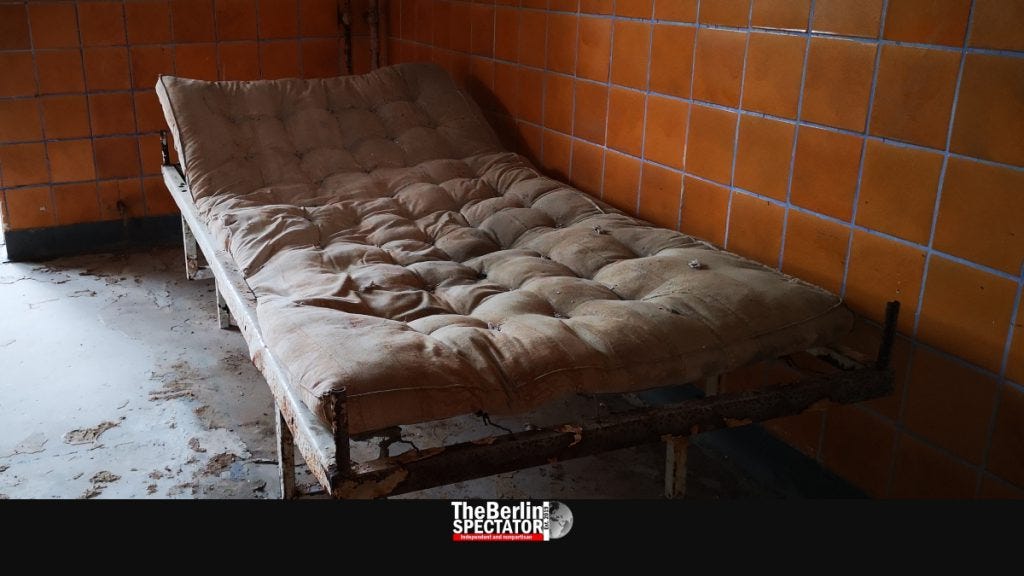
What patients went through in this building many decades ago is far more scary than anything tourists will see. In the early days, they underwent surgery without anesthesia. Later, the anesthesia available was unreliable, meaning patients would wake up during surgery, and they would have to be held in place by a bouncer-type muscle guy while they screamed because of the pain they had to endure.
Genders Separated
The construction of the first sanatorium for lung patients in Beelitz commenced in 1898. Completed in 1930, three years before the Nazis took power, this place became one of the largest hospital complexes around Berlin. The history of the Beelitz Sanatoriums is connected to the war and its consequences.
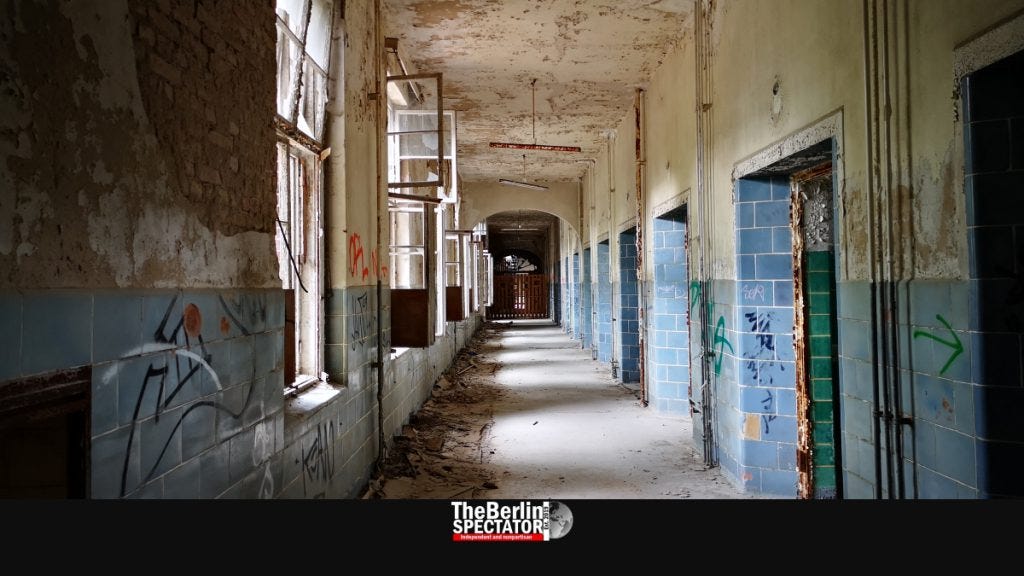
Back then, the genders were separated. This applied to both patients and staffers. There were sanatoriums for female lung patients, for male ones, dormitories for female nurses and doctors, as well as for their male colleagues, in different buildings. In 1908, the total number of beds was doubled from 600 to 1,200.
Patient Hitler
Technically, the hospitals in Beelitz were always top-notch. In 1903, the local heat and power station already used the power-heat coupling technology. The balconies for lung patients were equipped with plugs for headphones.
In both World Wars, the Beelitz Sanatoriums were used as hospitals for wounded soldiers. Private Adolf Hitler was treated here in 1916. When Nazi Germany was defeated, in 1945, the Soviets, and later the Russians, took over the partially destroyed buildings in Beelitz. They set up their own hospital there. It was the largest Soviet military hospital outside the Soviet Union.
Patient Honecker
The Russians used Beelitz until 1994. Russian signs still show the way to surgery in the ruin. In 1990, the GDR's former dictator Erich Honecker was treated in Beelitz for liver cancer, before he was flown to Santiago de Chile in 1993, where he met his wife Margot and died a year later.
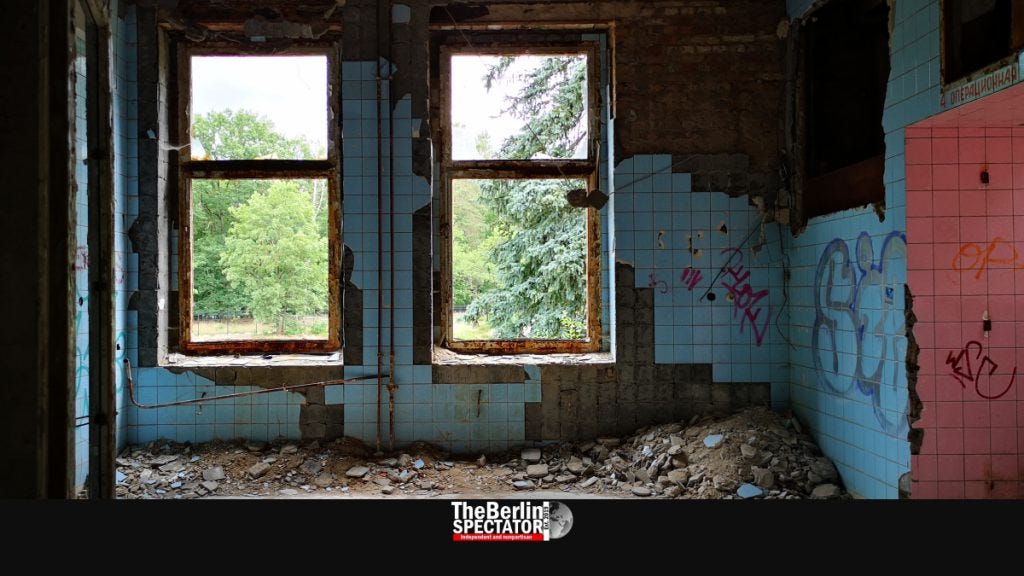
Now, step by step, the sanatoriums are being refurbished. But there are enough decaying buildings to look at, from the inside and outside, and even from above. Beelitz is a tourist haven today. Apart from those tours through the former surgery ward, a Treetop Path lets visitors see beautiful Brandenburg forests up and close, along with decaying former hospitals.
Costly Affair
For Berliners, getting to Beelitz by car is easy. From the German capital's Kreuzberg district, it is a 45-minute trip without traffic, and up to twice that time with traffic jams. From the train station in Beelitz, there is a shuttle bus that takes visitors to the Treetop Path, the old surgery ward and the 'Bare Foot Park', an excellent location for families with children.
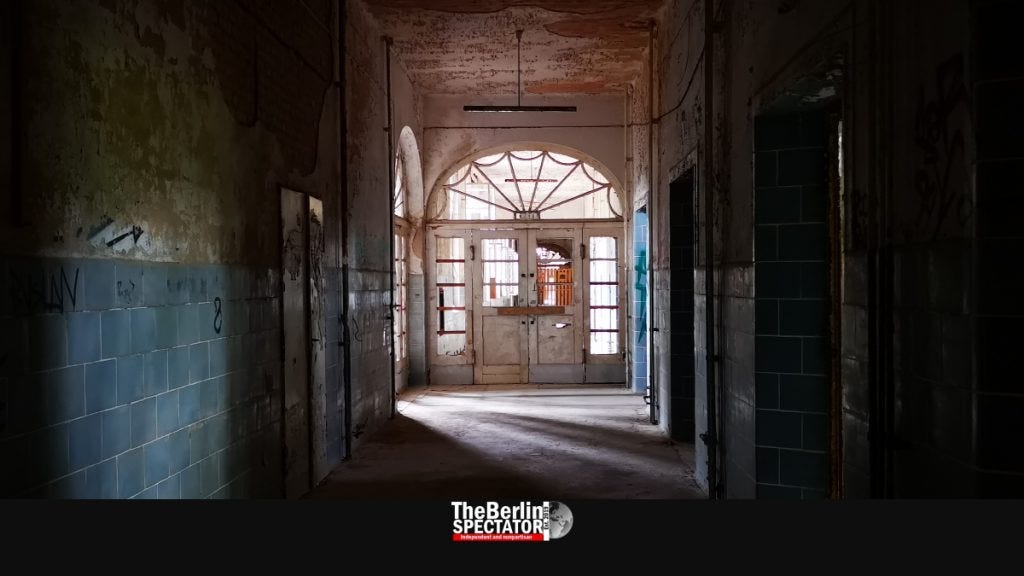
There is one downside: Any visit to Beelitz is a sort of costly affair. Regular tickets for the Treetop Path are 9.50 Euro Euro (12 Dollars or 10 Pounds) per person, and those for the sanatorium tour are 13.50 Euro. There is no tour through the building without Treetop Path tickets. This rule almost doubles the price for the tour. Still, any Berliner or expat Berliner should see Beelitz at least once.
Lots of motion pictures were shot in Beelitz, including 'Valkyrie' with Tom 'Clear' Cruise ('Clear' is a term used in his Scientology cult) and Roman Polanski's 'The Pianist'. A German film entitled 'Heilstätten' ('Sanatoriums') about this very place in Beelitz was supposed to be shot there too, but the owners did not agree. So the Beelitz flick was not filmed in Beelitz itself.
Their official website is a little weird. Its English version is German. It can be accessed here .
The Berlin Spectator needs your support. There are two ways to contribute, as you can see on our Donations Page . Thank you very much.
Ready for more?
- Recommended Reports – some selected highlights
- Bonus Post / non Urbex
- Chernobyl & Pripyat
- Churches and religious
- Derps and Miscellaneous
- Farms, Country Cottages and Smaller Houses
- Hospitals & Asylums
- Industrial & Commercial Sites
- Leisure Sites
- Military Sites
- Palaces, Castles & Mansions
- Schools and Educational
- Subterranean
- United Kingdom
- One Photo From Every Explore
- Portfolio & Shop
Explore #94e (revisit): Beelitz-Heilstätten – Men’s Sanatorium, Germany – May 2016
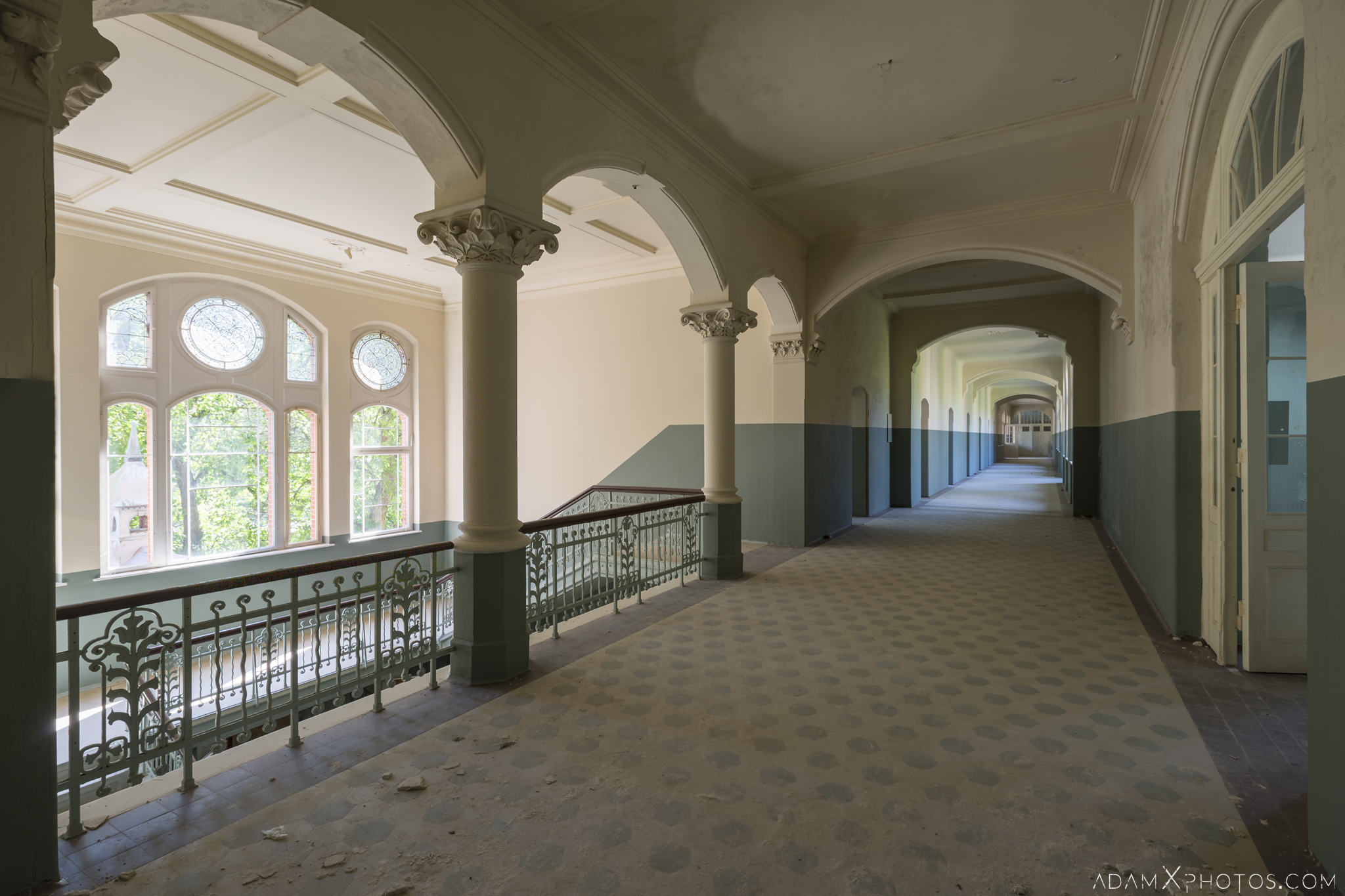
Explore #25 of ‘The Picnics & Palaces Tour’
We left Poland and headed back towards Berlin for what turned out to be a rather brief and sad revisit to this former military sanatorium, which James and I had first explored in much greater depth back in August 2014 .
History Originally built in 1898 on the plans of architect Heino Schmieden, this vast complex of approximately 60 buildings was designed as a sanatorium for the Berlin workers’ health insurance corporation to treat lung diseases such as tuberculosis, which at that time killed nearly 1 in every 3 Berliners.
Following the outbreak of World War I, Beelitz was used as a military hospital for the Imperial German Army. A young Adolf Hitler was (in)famously treated here between October and November 1916 after being wounded in the leg at the Battle of the Somme.
Beelitz was used as a field hospital to treat wounded Nazis during World War II. It was occupied by Red Army Forces in 1945, and remained a Soviet military hospital for the next 50 years until 1995, well after the fall of the Berlin wall.
In April 1990 Erich Honecker was admitted to Beelitz, after being forced to resign as the head of the East German government on 18 October 1989 shortly before the fall of the Berlin wall on 9 November 1989. It was here that he was diagnosed with the malignant liver tumour from which he died in May 1994.
The site gained further notoriety around this time when the serial killer Wolfgang Schmidt, also known as the Pink Giant or The Beast of Beelitz, murdered four of his six victims in the hospital grounds during 1990.
Yet another dark episode in Beelitz’s recent past occurred in 2008, when a well-known photographer called Michael F brutally murdered a 20 year old model called Anja P with a frying pan after having photographed her, and then had sex with her corpse.
Following the Soviet withdrawal in 1995 attempts were made to privatise the hospital, but none were successful. Today a few small sections are used for neurological rehabilitation and Parkinson’s research, but the majority of the vast complex lies decaying.
In recent years the site has also been used as a film location, as well as for music videos by the likes of Rammstein.
Our Explore We didn’t know whether the Men’s Sanatorium and Bathhouse would still be accessible, but seeing as we were in the neighbourhood we thought it would be worth a look. The Bathhouse was a quick failure – freshly secured and with remote alarms attached to nearby trees. After triggering one we hopped back over the fence and decided on a fresh angle of attack – this time on the main Sanatorium building. A painstaking approach through woodland, and we managed to find a point of access which avoided the remote alarms.
Unfortunately as soon as we found our way inside we were confronted with a very different looking building to the decay porn which James and I had enjoyed on our previous visit. I have since found out that the building was redecorated to be used as part of the set for the 2016 film ‘A Cure For Wellness’.
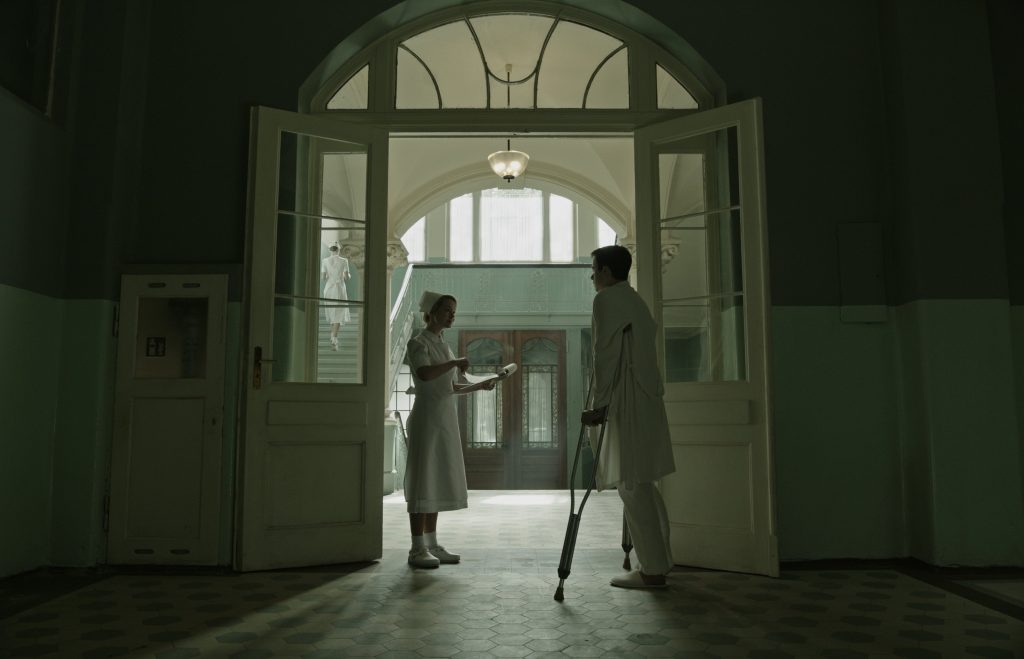
Whilst I suppose I should be glad that the fantastic building is still being put to some practical use, we were all gutted to see that the peeling paint had been replaced with a basic new paint job. We decided not to hang around, but took a few shots just to document the changes.
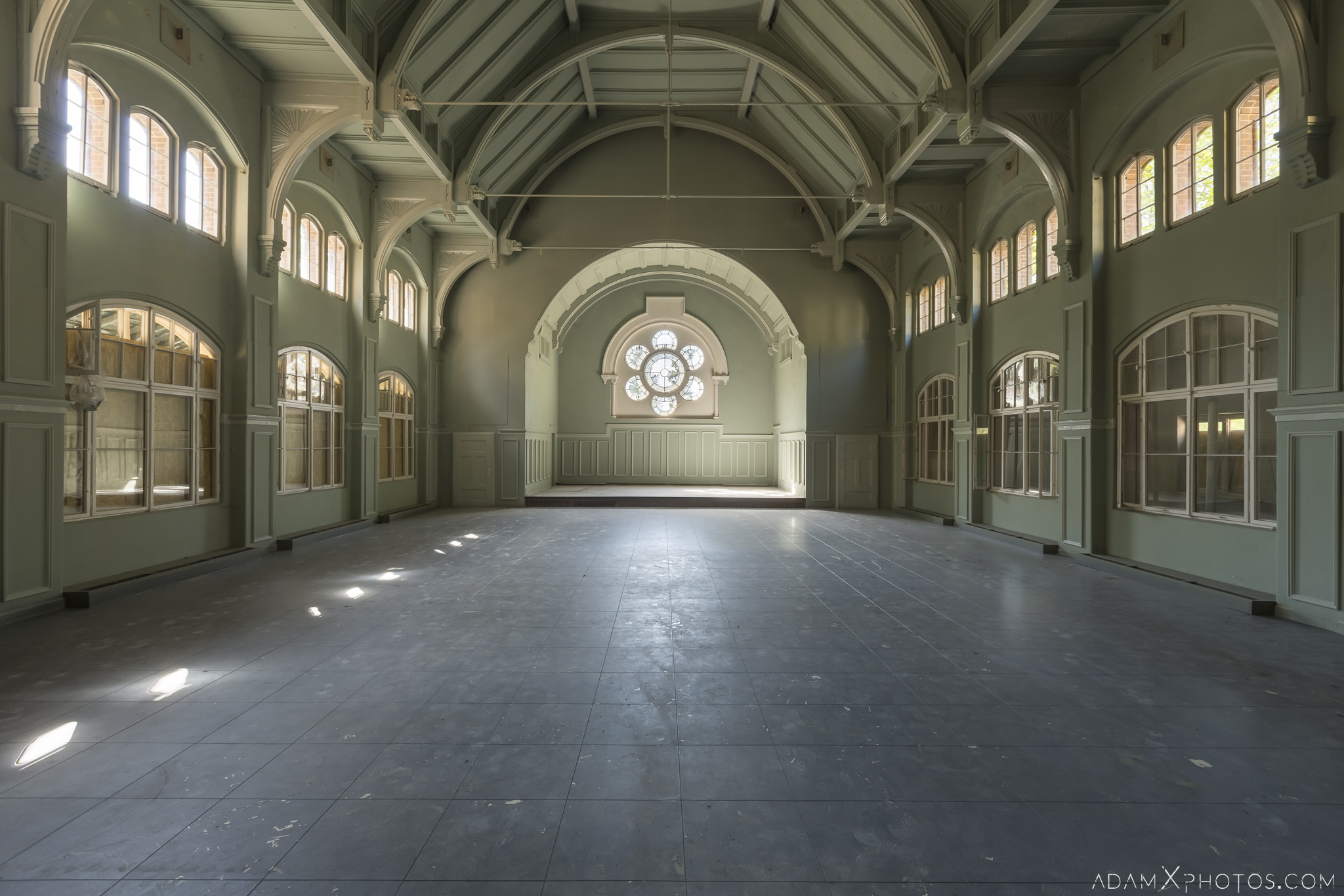
Below are a couple of images which I’ve created by blending one of my shots from August 2014 [left] with the same view in May 2016 [right].

We then headed off to try and squeeze in one last explore before we caught our afternoon flight home…
Thanks Adam X
I just watched “A Cure for Wellness” and did some post-movie research on the filming locations. Thank you for taking the time to blend the old/new photos of this place – they really give a good sense of the work that Verbinski put into his movie sets. And while I can understand your disappointment at finding a renovated scene once inside, I for one am glad that the buildings were put to good use.
Thank you for your kind comments, and I’m glad you enjoyed my images!
I only got to see the revamped version on a paid tour – but it was my first Urbex experience & it left quite an impression regardless. I went back 6 months later as I realised how much there is to see. It gave me a zest for new Urbex places & I’ll return to Berlin soon to try 6 or 7 spots on the list. Thanks for the great comparison photos!
Thanks Robin – yes it’s an incredible place, and I’m so glad I managed to see a large part of it when I did. Glad the photos were of interest! Cheers, Adam
Thanks Robin, I hope you have a great trip – there are so many great locations near Berlin.
Leave a Reply Cancel reply
Enter your email address to receive notifications whenever a new post is published.
Email Address
Never see this message again.
- Skip to content
Beelitz Sanatorium
Beelitz, a small town in the county of Brandenburg. There, you find the Beelitz Heilstätten – Beelitz Sanatorium – a heritage-protected complex, built between 1898 and 1930.
Around 60 buildings were constructed for the Beelitz Heilstätten on an area of about 200 hectares. Facilities for treating pulmonary diseases were placed north of the train tracks, south of them were facilities for noninfectious diseases.

Patients were also separated by gender. Women in the buildings west of the main road, men east of the road.

During the World Wars, the facilities of Beelitz Sanatorium were used as a military hospital and sanatorium for the ill and wounded soldiers. The Red Army took the critically damaged buildings after the Second World War. They used the complex to create the largest Soviet military hospital on foreign soil. The hospital was closed in 1994.

Since then, some of the buildings have been refurbished. They now house a neuro-biological rehabilitation clinic, a specialist Parkinson’s clinic and rehabilitation facilities for children.

Sadly, due to bankruptcy of the owners in 2001, the refurbishment of the remaining buildings has stopped.

Now, the complex is a surreal and mysterious sight just off the road. Dilapidated buildings, overgrown gardens and almost forgotten relics of the past. We explored the premises by ourselves and walked away with some remarkable impressions.

We didn’t dare to go inside the buildings as some of them looked structurally unsound. But we peaked through windows and saw a few details, for example, the tiles in the rooms that still gave off that distinct hospital vibe.

Too bad that the complex is so run down. I hope that all buildings will one day be fully refurbished.

When we visited the Beelitz Sanatorium it was not permitted to enter the buildings. Now there are official guided tours for the premises, including the buildings.
- share
- share
- save 0
Related Posts:
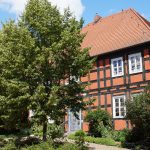
Reader Interactions
Leave a reply.
Your email address will not be published. Required fields are marked *
Save my name, email, and website in this browser for the next time I comment.

Home » Blog » Travel » Reviews » Experiences » Abandoned Medicine – Beelitz Heilstätten
Abandoned Medicine – Beelitz Heilstätten
May 3, 2013 11 Comments »
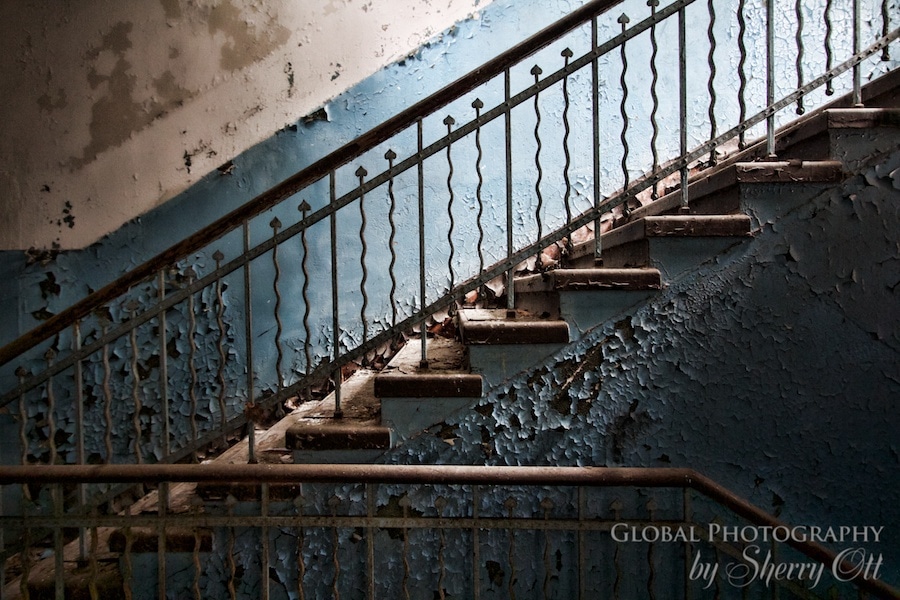
Beelitz stairway – history crumbling
The trees limbs were heavy with freshly fallen snow providing a peaceful backdrop on this entirely eerie place. I had made my way outside of Berlin to the little community of Beelitz on this snowy Easter weekend to photograph Beelitz Heilstätten, a sanatorium for tuberculosis treatment methods in the early 20th century.
In 1898 Beelitz Heilstätten opened with 600 beds to treat the ill. The sanatorium was strictly divided along gender lines: women were accommodated to the west of the main road, men to the east. As it grew over the next few years more buildings were added and it turned into a ‘city for the ill’ with a post office, restaurant, stables, water tower, power plant, butcher shop, and even a beer garden. As time and history marched on around Berlin the sanatorium also served at a wartime hospital, and a GDR hospital, in addition to continuing to serve TB patients with ‘advanced technology’.
The extensive sanatorium ‘campus’ has been abandoned since 1994 and now is in the familiar limbo of many historic, unused buildings in/around the Berlin area . While the government and owners decide what the fate of the Beelitz campus is, companies like Go2know have been granted special permission to run photography tours through the crumbling buildings. The site is so extensive that they have separate photo tours for the men’s and women’s section.
I took the photo tour to the women’s section of the sanatorium and we were able to walk around the snowy grounds and inside 3 main buildings and photograph to our heart’s content. I love these tours since they are a great setting to practice with lighting and composition. I didn’t take a tripod with me – so that makes it even more challenging in these low light situations. The tour information was only provided in German – but there were enough people there to translate for me and honestly I was there to do photography – so I didn’t need much guidance. And quite frankly – the ‘leader’ simply gives an overview of the history, buildings, and things to be careful of or special things to see, he hands you a blueprint layout of the buildings, and then you are own your own for 4 to 5 hours to explore! The ultimate photography tour if you ask me!
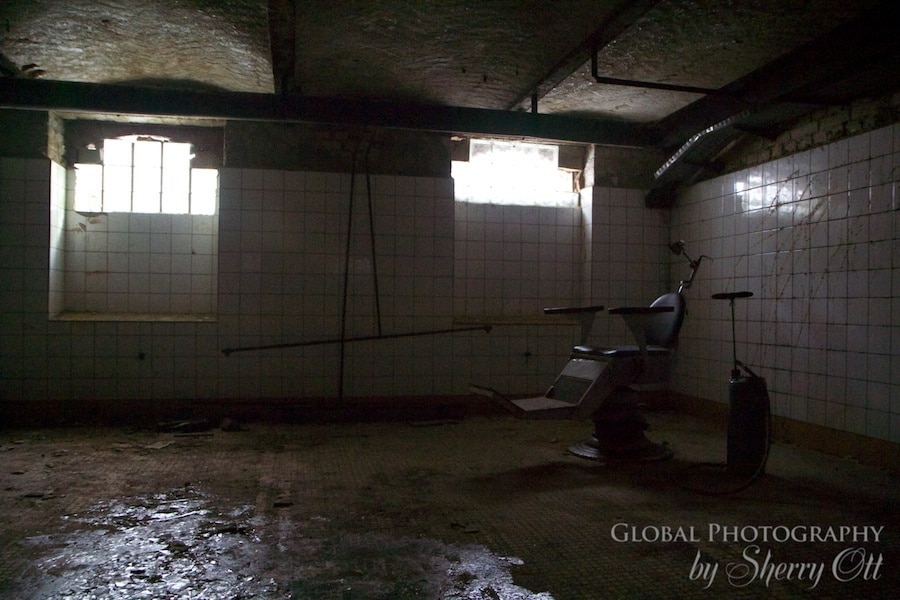
Dental work anyone?
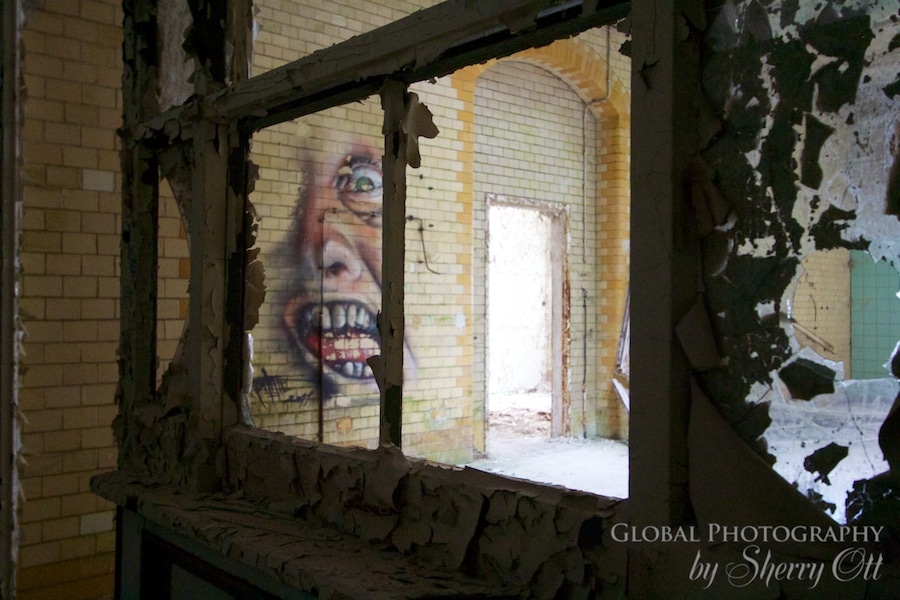
Most of the site had very little graffiti – it must be protected quite well.
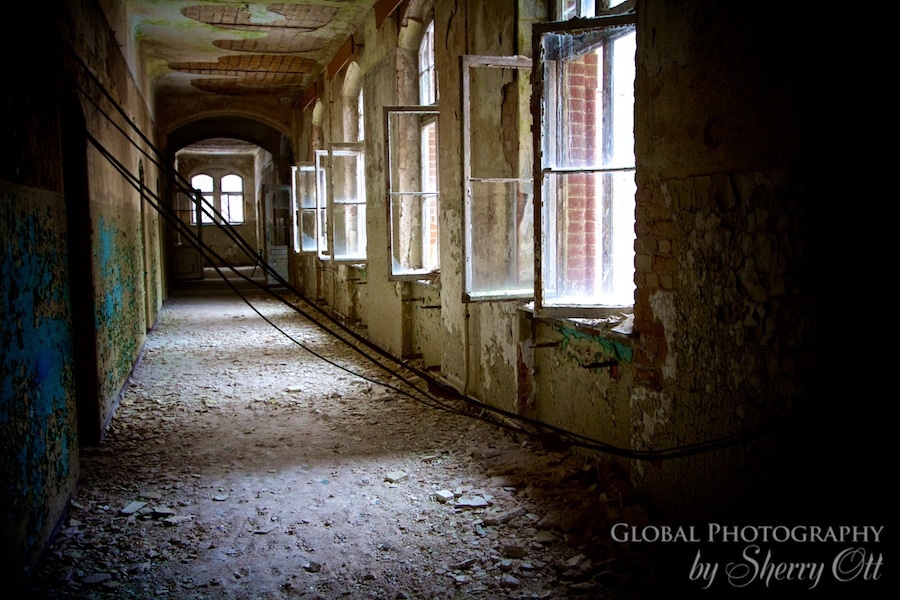
Hallway in the medical building
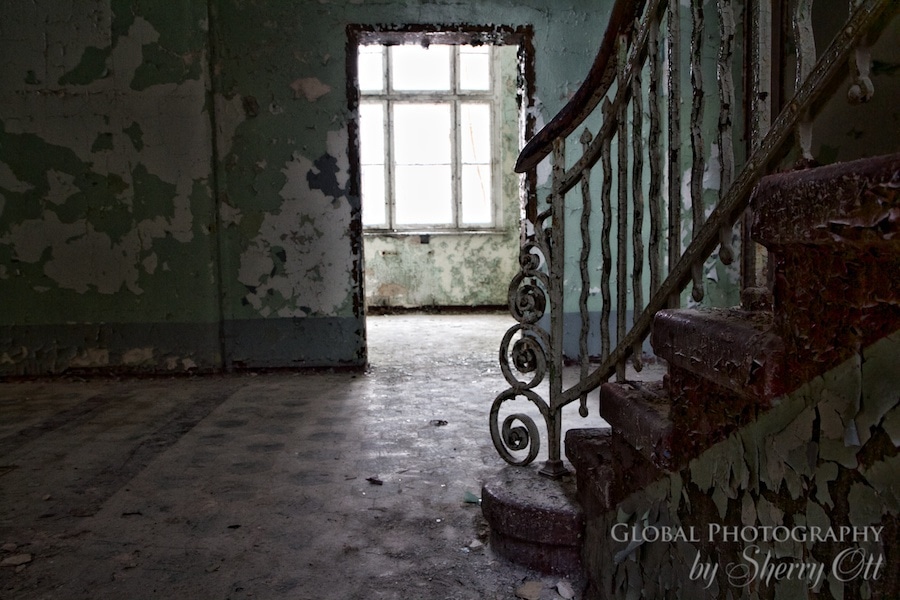
Iron work railing of the dilapidated stairway
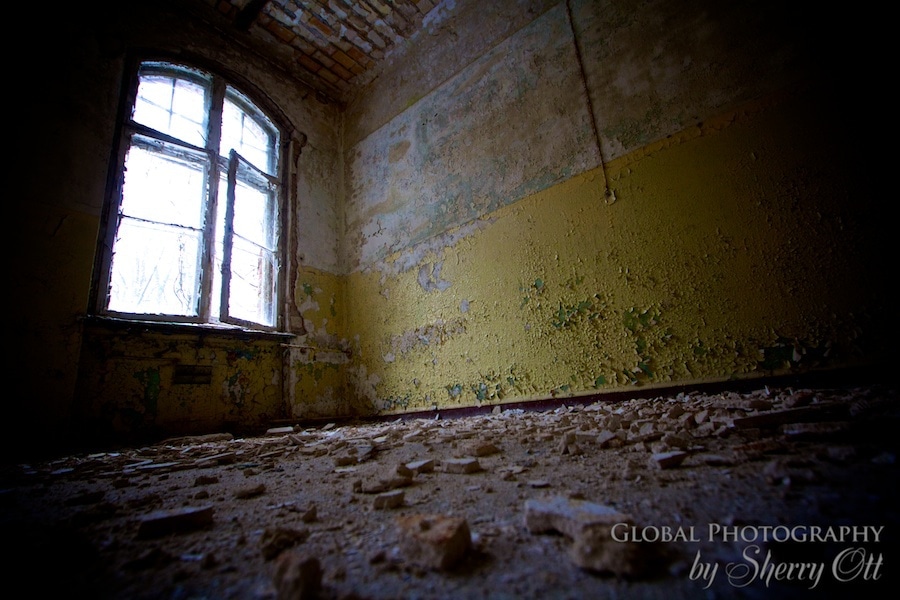
Room in the hospital ward
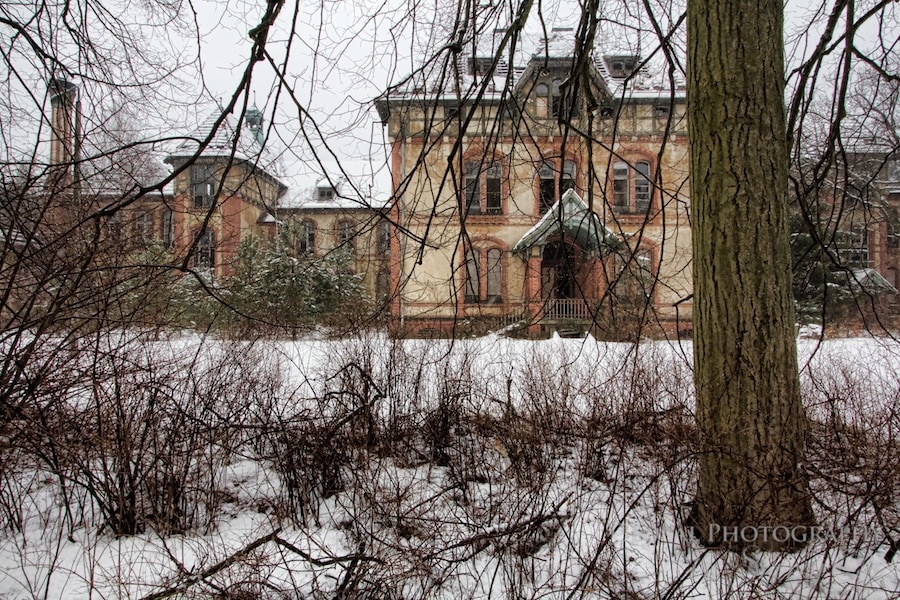
One of the Women’s medical buildings on a snowy day
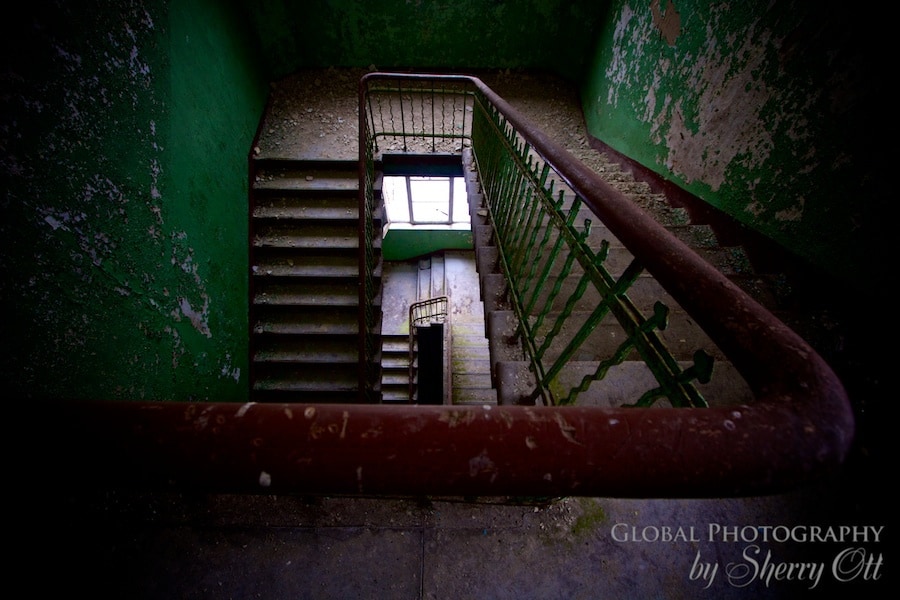
A back stairway
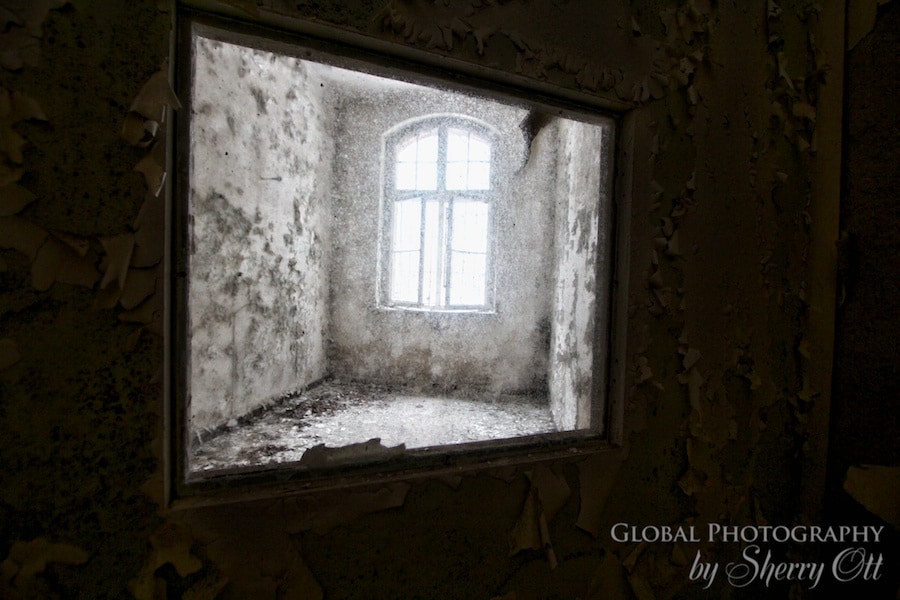
Room in the women’s clinic
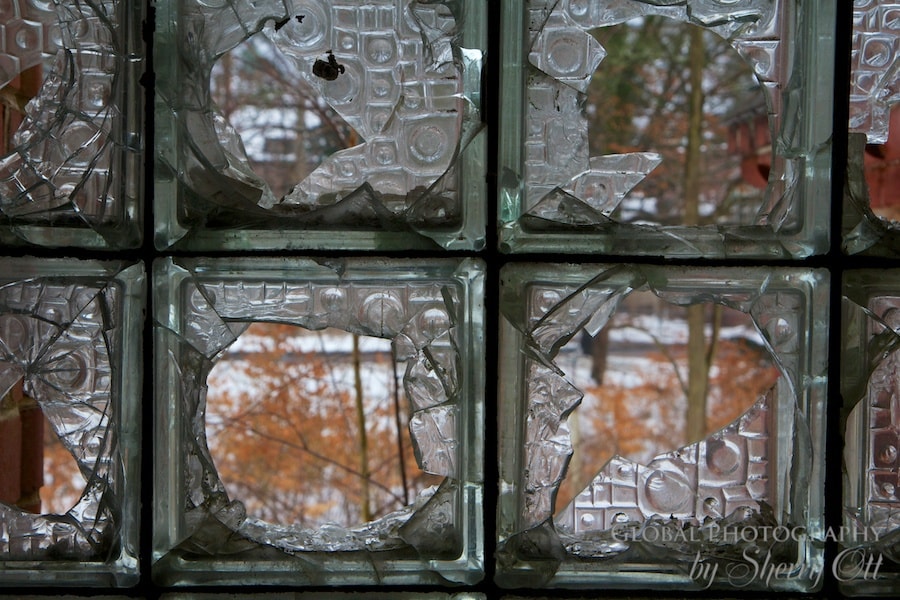
Broken windows were common among the abandoned facilities
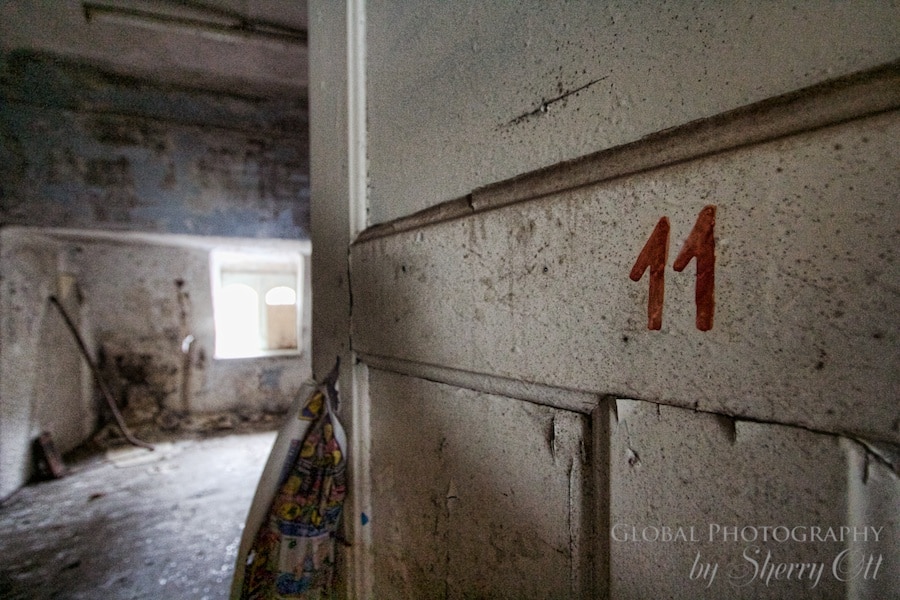
A crumbling wall
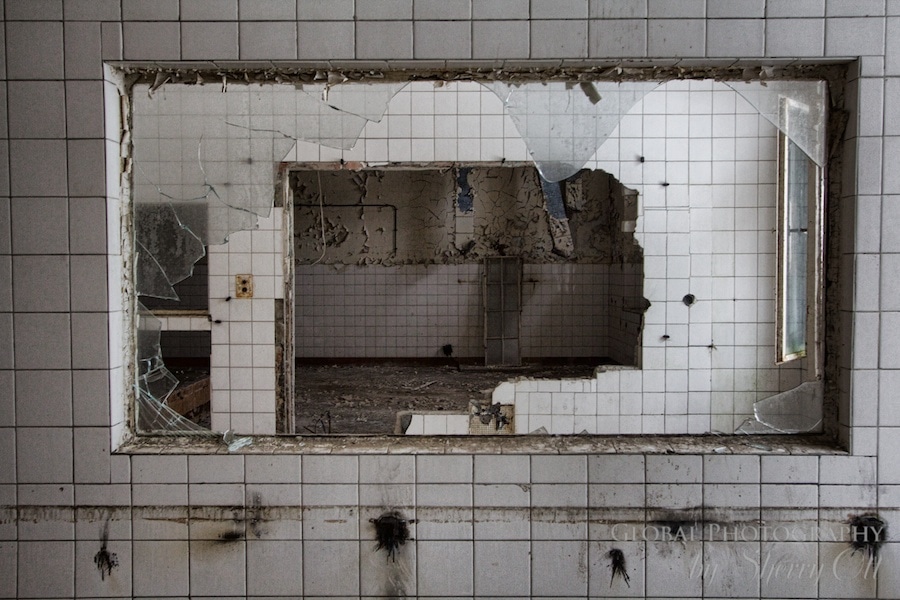
An old cafeteria
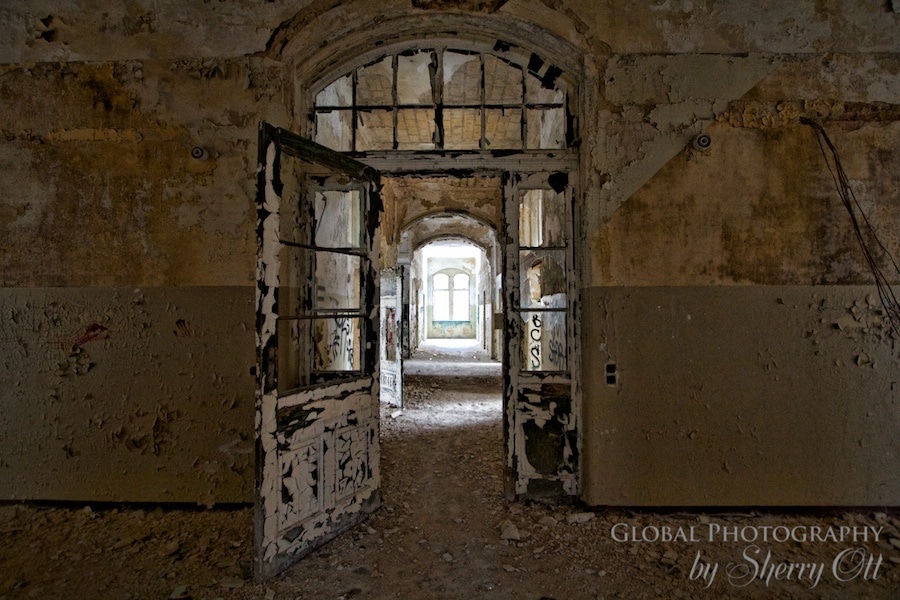
Remnants of a once beautiful building
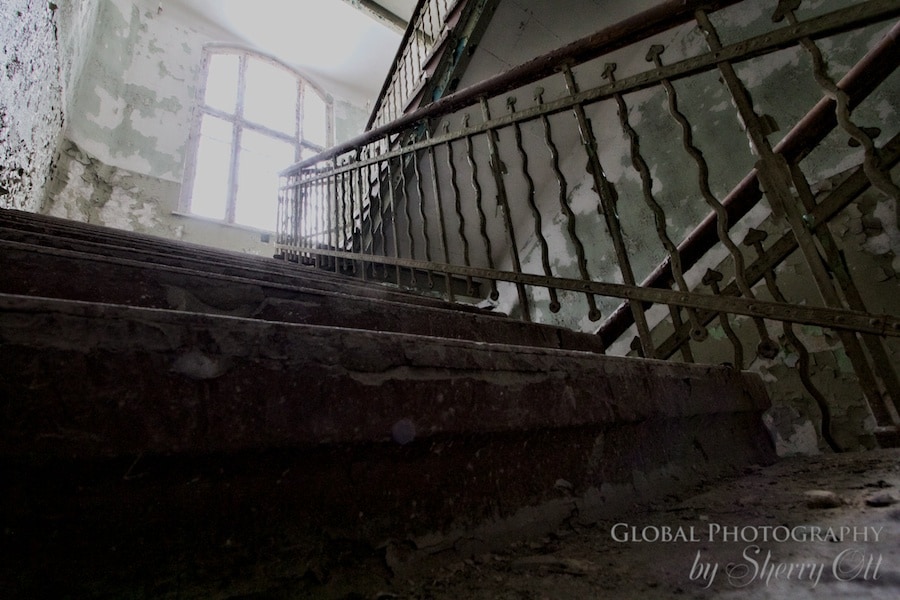
A perfect photo tour to really practice with lighting situations.
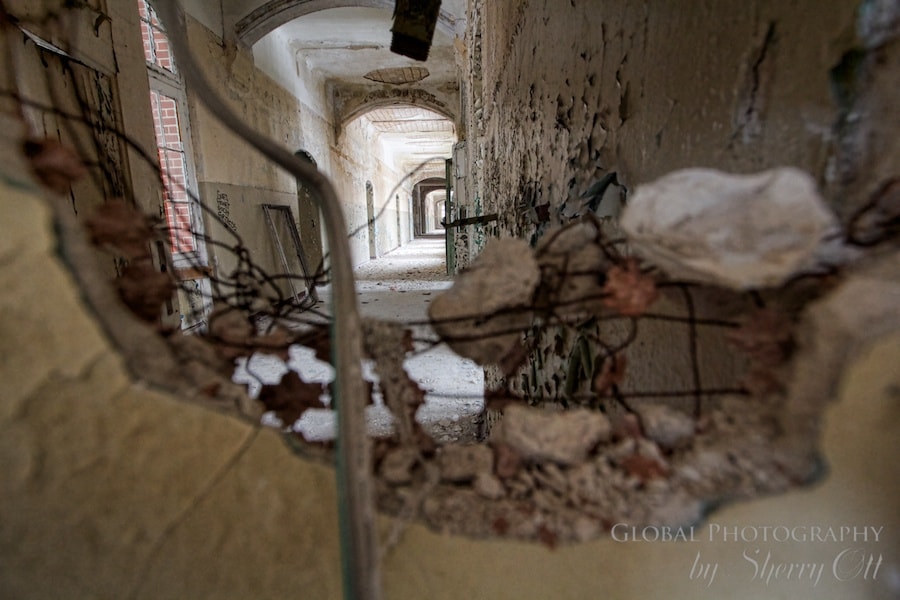
Looking through a wall in the clinic

A beautiful old circular window
View all of the Beelitz photography from my tour here
See other Berlin photo tours I’ve taken with Go2know.com Paper Mill Meat Factory
Other Berlin Photo tours: Spreepark – Graveyard of Fun
More Info: Beelitz History Photo Tour Information specializing in Abandoned Berlin
11 Responses to "Abandoned Medicine – Beelitz Heilstätten"
By Maria May 3, 2013 - 7:23 am
I love these spaces – exploration, adventure and then I fall into pondering, who used to walk those halls and what were they like? Fantastic.
By Bastiaan May 3, 2013 - 9:16 am
Fantastic pictures! It makes me want to discover Germany. I live so close but I never properly visited Germany. Looks like they can shoot a horror movie in this place… haha.
By Larissa May 4, 2013 - 9:06 pm
Love exploring abandoned sites like this, and had not heard of this one–fantastic and spooky photos 🙂
By Yeity May 7, 2013 - 3:23 am
Holy that is so spooky! Thanks the lord you were in a tour- can you imagine all on your own eeekkk
By Amy May 7, 2013 - 7:16 pm
I’m glad I came across this post because I recently (like two weeks ago) got into “abandoned building” photography. I’ve just been wandering around and getting shots where I can; I had no idea some places actually do photography tours.
Left me wondering though…how much do these cost?
And I love the shots you got. Hauntingly beautiful.
By Sherry May 13, 2013 - 7:36 am
The Go2know tours range in price – but normally around 30 to 40 Euro for 5 hrs of time at the building to wander and photograph
By Sam @ Travellingking.com May 7, 2013 - 9:28 pm
WOW! I am lost for words, this place in incredible and having the opportunity to photograph it would have bee incredible. Thanks so much or sharing!
By Betsy May 20, 2013 - 11:49 am
Eerie but incredible photographs! Love the textures. That dental chair is definitely frightening!
By Dariel June 17, 2014 - 12:54 am
Amazing photos! Always envy photographers who see things other people don’t (no pun intended, especially in this eerie place)!
By Mariana April 19, 2016 - 6:21 pm
I would love to visit the Beelitz’s Abandoned Sanatorium, how do I go about to book a phototour? I am from South Africa and will be in Berlin for May & June 2016
By Sherry April 21, 2016 - 9:40 am
Mariana – I did the tour with a company called Go2Know – here’s their website – http://www.go2know.de/Fototouren/Beelitz-Heilstaetten-Frauenklinik ::217.html
Leave a Reply Cancel reply
Your email address will not be published. Required fields are marked *
* Your Name
* Your Email
Save my name, email, and website in this browser for the next time I comment.
Notify me of follow-up comments by email.
Notify me of new posts by email.
Who is Sherry Ott?
I'm Sherry, a corporate cube dweller turned nomadic traveler. I travel to off-the-beaten-path destinations to bring you unique travel experiences and photography. But it's not just about travel, it's also about life experiences of a middle age wanderer.
Learn More New? Start Here!
Follow my Travels.

Get my best travel tips,
Unique destination ideas,, and travel discounts, in my weekly email.
Never see this message again.

IMAGES
VIDEO
COMMENTS
Zeitenwandel - Wandelzeiten (Changing times - time to stroll) A walk through the history of and stories about the Beelitz sanatorium. You will spend one hour strolling along the historical paths of the Beelitz sanatoriums together with our knowledgeable tour guides, getting to know some interesting and funny details from the patients' lives between the solarium, the dining hall and the ...
Photo walking / tour of old buildings "Sanatorium Beelitz-Heilsatten, Germany" which is near Berlin. These photos and the actual location is down the road about a half of a mile from the train station. This is something my 13 year old daughter wanted to do. This is almost a full day event so make sure that you have good shoes (hiking boots is ...
The forests around Beelitz, just 50 km from central Berlin, were ideally suited for this purpose. Like a small town all its own. The sanatorium site was enlarged in 1928, adding a surgical hospital, a laundry, and even a small shopping arcade with six stores (a cobbler, a stationer, a soap workshop, a bakery, and a tailor). Soon there was room ...
Built in 1898, this disused hospital complex of approximately 60 buildings located in the district of Beelitz Heilstatten. Between 1898 and 1930 the complex served as a sanatorium for lung ...
The vast abandoned sanatorium complex known as Beelitz Heilstätten, southwest of Berlin, is surely one of the city's most flagrantly open secrets.. Easily reached by train from Wannsee, Beelitz is a mythical destination for aficionados of urban exploration (urbex): the clandestine visiting, photographing and filming of abandoned buildings, as well as being an oddly popular spot with ...
View: Unique views of the Beelitz-Heilstätten historic garden, building and technical monument and the enchanted wooden park landscape Other facilities and attractions: Castle-style hospital complex; gigantic World War ruin with rooftop forest featuring a 20 metre-high treetop walk; trails through the park landscape; forest playground.
The sanatorium was constantly being expanded up until 1930; in the end it could care for over 1,000 patients. During both World Wars, the Beelitz facility was primarily used as a military hospital for wounded soldiers. In April 1945, the 12th German Army convened on Beelitz in order to break through the Soviet ring around Berlin.
Explore the Beelitz Heilstätten from above on a 320-meter treetop walk with this entry ticket. ... The walk offers a unique perspective of the Beelitz-Heilstätten, a former sanatorium turned historical ruin, enveloped by lush forest. ... 18 Berlin Cruises & boat tours. 19 Berlin Guided tours. 20 Berlin Family-friendly activities. Cities in ...
It started out life in the early 20th century as a Sanatorium for TB, then military hospital. The buildings are ruins now but some are getting restored. ... Nature & Parks in Beelitz Tours & Activities in Beelitz. Balloon Rides in Beelitz. Outdoor Activities in Beelitz. Balloon Rides in Beelitz. Things to do near Beelitz-Heilstätten.
Answer 1 of 4: I'm keen to visit the beelitz sanatorium - can anyone recommend tours or guidance on visiting? I have been to Berlin before and didn't make it last time as I visited Tempelhof. I enjoy abandoned buildings! I've seen go2know seem to offer photo...
The Baumkronenpfad Beelitz-Heilstätten is a treetop walkway that winds its way for 320m over, between and around the buildings at the abandoned sanatorium just outside Berlin.. The history of the Beelitz-Heilstätten began in 1898 when the Landesversicherungsanstalt Berlin (the state insurance institute for Berlin) bought an approximately 140-hectare parcel of woodland from the town of Beelitz.
Straße nach Fichtenwalde 13 14547 Beelitz. Tel.: +49 (33204) 634723 E-Mail: [email protected]. Nature, history, and architecture have begun to meld together in this spot into what some might call a masterpiece. High in the treetops In September 2015, the first treetop path in Brandenburg was opened on the grounds of this former sanatorium ...
Since the treetop walkway opened in 2015, Beelitz has become a popular day trip destination for Berliners and others who live in the surrounding region. Before then, the Beelitz Heilstätten was the domain of urban explorers and others willing to jump the fence of the ruined tuberculosis clinic.
Beelitz-Heilstätten Forest Park. Over 100 years ago, Beelitz sanatorium, which is still famous today, was built just outside Berlin, not far from Potsdam. The workers of the imperial capital were to recover from tuberculosis, which was rampant at the time, surrounded by forests, sophisticated architecture and generous forest parks.
Beelitz is a former Sanatorium, now completely dilapidated and overgrown with trees. Today, you can walk through the canopy on a treetop walk, called the Beelitz Baumkronenpfad ("Beelitz Canopy Path"). Some say the hospital ruins are haunted, and when you take a tour through the parts of it that are still accessible, you might get an idea why.
The eventful history of the Beelitz sanatorium. To examine the beginnings of Germany's largest pulmonary hospital, we have to travel back in time 130, 140 years. In the late 19th century, German industry was booming and hundreds of thousands of workers and their families were living together in cramped quarters in the metropolises.
There is one downside: Any visit to Beelitz is a sort of costly affair. Regular tickets for the Treetop Path are 9.50 Euro Euro (12 Dollars or 10 Pounds) per person, and those for the sanatorium tour are 13.50 Euro. There is no tour through the building without Treetop Path tickets. This rule almost doubles the price for the tour.
Explore #25 of 'The Picnics & Palaces Tour' ... Beelitz was used as a field hospital to treat wounded Nazis during World War II. It was occupied by Red Army Forces in 1945, and remained a Soviet military hospital for the next 50 years until 1995, well after the fall of the Berlin wall.
Beelitz-Heilstätten, Beelitz: See 201 reviews, articles, and 598 photos of Beelitz-Heilstätten, ranked No.1 on Tripadvisor among 7 attractions in Beelitz. ... It was extended but building separate units during the 20 Century and was an army hospital during the 2 world wars.Some famous, or infamous people have been treated there, Hitler, Putin ...
Beelitz, a small town in the county of Brandenburg. There, you find the Beelitz Heilstätten - Beelitz Sanatorium - a heritage-protected complex, built between 1898 and 1930. Around 60 buildings were constructed for the Beelitz Heilstätten on an area of about 200 hectares. Facilities for treating pulmonary diseases were placed north of the ...
I had made my way outside of Berlin to the little community of Beelitz on this snowy Easter weekend to photograph Beelitz Heilstätten, a sanatorium for tuberculosis treatment methods in the early 20th century. In 1898 Beelitz Heilstätten opened with 600 beds to treat the ill.
It started out life in the early 20th century as a Sanatorium for TB, then military hospital. The buildings are ruins now but some are getting restored. ... Nature & Parks in Beelitz Tours & Activities in Beelitz. Balloon Rides in Beelitz. Outdoor Activities in Beelitz. Balloon Rides in Beelitz. Things to do near Beelitz-Heilstätten.
The Baum und Zeit attraction only lets you into a comparatively small part of the site—most of the big buildings are closed. There's a company called go2know (www.go2know.de) who do (quite expensive, about €70) "photobases" where they open up the site for small groups and you can spend several hours exploring independently.Personally, I think it's worth it—I've been on a couple ...